PAG OUTDOOR Enjoy and explore a true paradise for lovers of active vacation, nature and adrenaline!
HOT SPOTS DESTINATION WINTER/SPRING 2023.

Whether you enjoy trekking, bike, hike, climb, kayak or practice any activity you can
imagine in between, Island of Pag is a true paradise for lovers of active tourism,
nature and adrenaline.
SYNERGY THAT KNOWS NO BOUNDARIES
Pag Outdoor is a project which is the result of the joint efforts of as many as five tourist boards - The Tourist Board of the City of Novalja, The Tourist Board of the City of Pag, the Kolan Tourist Board, the Povljana Tourist Board and the Stara Novalja Tourist Board. It is carried out with the support of the Ministry of Tourism and Sport of the Republic of Croatia (MINTS).
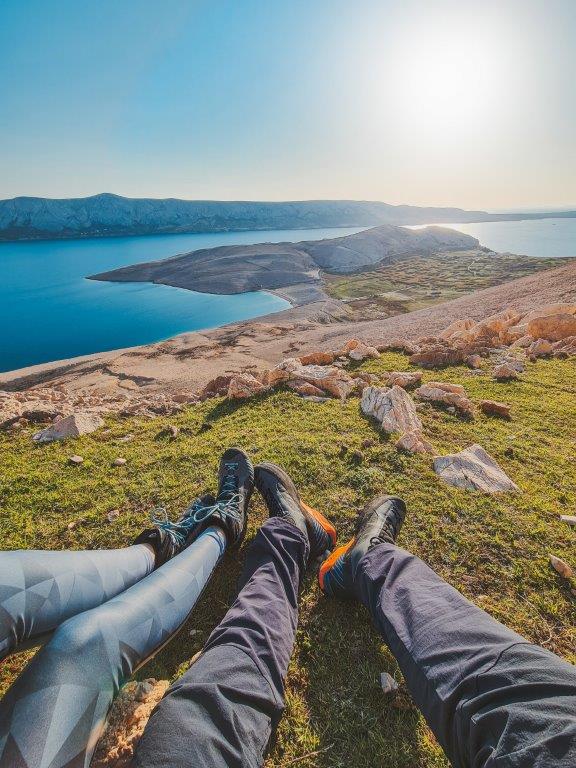
Regarding Pag’s rich outdoor offer, it is important to say that the whole story includes licensed guides and trainers who add to the entire experience with their own experience, as well as the local DMC tourist agency.
Of the striking four-leaf clover which marks Pag’s outdoor offer, perhaps the most peculiar is the one that is actually the “birth certificate” of the island, unique because of its resemblance to the surface of a distant planet; some will see Mars in it, some will see the Moon, but this island is certainly attractive precisely because of that unique landscape. This is how the famous Life on Mars Trail Race was born.

THE LIFE ON MARS TRAIL
This year, Novalja wins the Simply the Best award with Life on Mars for the exceptional quality and attractiveness of this event, which enriches the whole tourist offer with its content while promoting the sustainable development of active tourism, it also firmly positions Novalja at the very top of the Croatian outdoor destination list. Unspoiled nature surrounded by the awe-inspiring smell of sea, stone and salt represents a true break from the stressors of
everyday life and a “psychological detox”, and as such - according to the runners - the aforementioned track has definitely earned its “five stars”.

The Life on Mars trail has also been rightfully adorned with an award from the readers of “People Outdoors” magazine for the best outdoor tourist infrastructure, with its many marked trails and coordinates.
It should be noted that the Trekking League in cooperation with the Tourist Board of the town of Novalja organises the Life on Mars race every spring, and the exotic Metajna canyon is the attractive location of the most popular trekking race in all of Croatia, a race characterised
by its truly distinctive “cosmic beauty”.
However, it would be unfair not to mention the fact that Pag boasts as many as eight excellent running tracks.






SAY CHEESE AND RUN!
The outdoor Island Pag Trail Race is the perfect place to mingle with other enthusiasts and conquer some exciting trails. The race is held every year in April, and the many participants have the privilege of discovering all the diversity and beauty of Kolan along several tracks. The trails are not too difficult, they are very interesting because they pass through Kolanjsko polje (the Kolan plain), the Kolanjsko blato ornithological reserve, all the way to Sveti Vid, the
highest point on the entire island of Pag. It offers an unforgettable view of all sides of the island, the imposing Velebit mountain range across the channel, as well as the islands of Maun, Silba and Lošinj. The Island Pag Trail guarantees a unique and unforgettable experience to all of its visitors who can enjoy engaging in sporting activities and delicious local cuisine, as well as beautiful natural sights and countless top quality food products from Kolan and the
rest of the island of Pag.
If you prefer being out in nature, being constantly on the move, if you enjoy progressing with dynamic and exciting adventures and competitions, and if you’re always looking for new things to try - come and visit the Island Pag Trail race in Kolan on the island of Pag.
Say cheese and run!



THE OTHER SIDE OF THE MOON TRAIL - PAG
The Other Side of the Moon is an area where three paths made of stoney magic are intertwined, with beautiful views of the mythical Croatian Velebit mountain, the gorgeous, azure blue sea, rugged rocks and the deep blue sky! Each of these paths has its very own
story, a number of interesting notes from Pag’s rich history and special views made of stone that only nature could shape. If you take any of these trails, enjoyment and relaxation are guaranteed because the paths pass Ledeniko, the most beautiful and interesting geological-paleontological part of the island of Pag, and entirely unique in the entire Mediterranean region.

If you like hearing historical stories, you will definitely be able to satisfy your curiosity
here, because when taking this trail, you will reach Veles’s closed cave, named after the god from Old Slavic mythology who leads his eternal cyclical battle with the god Perun. Given that Veles was depicted in the form of a snake or a dragon in Old Slavic mythology, when visiting this place, don’t bother to try to open this cave with some magic words.

This path, which is short, easy to walk along and accessible to all ages even in the warmer part of the year, can be used for a nice all-day family trip with swimming in the beautiful Zaton bay, and on the path itself you will come across two viewpoints which boast some utterly
beautiful views.
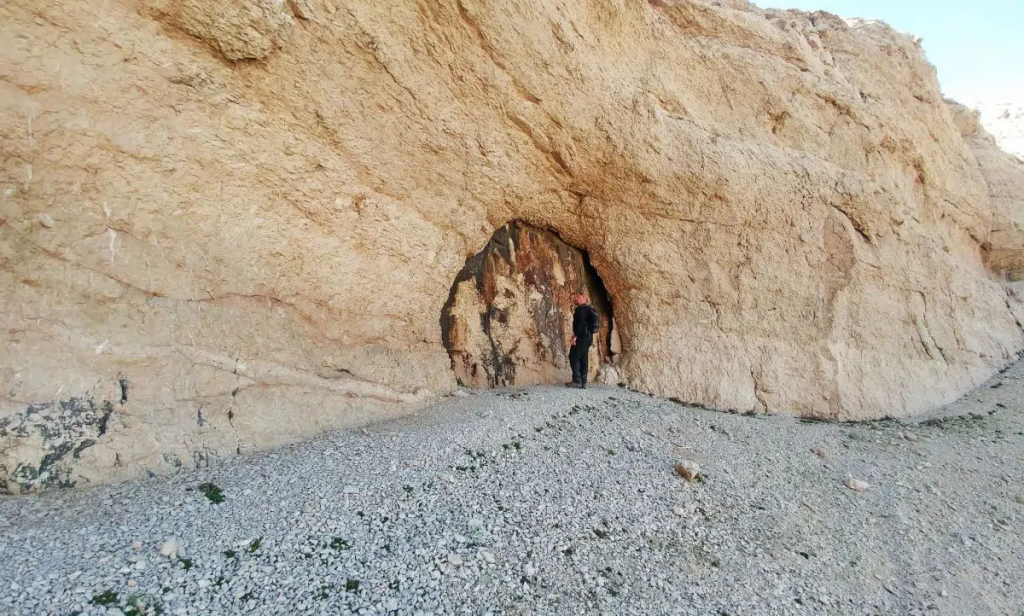
THE PANOSA TRAIL
This trail starts at Trg Ban Jelačića (Ban Jelačić Square) in the very centre of town and is very suitable for trail walking, Nordic walking or just plain old walking.
It starts next to the parish church of St. George (Sveti Juraj), through the wells - which in the past provided much needed water for the grazing cattle, and later became the water supply - walking along the asphalt road we reach the location of Obatnica, a place right down by the sea, where there used to be an ancient villa, which was later transformed into a monastery. After a short climb, we’ll reach the lookout point, which offers a view of the stunning surrounding islands.
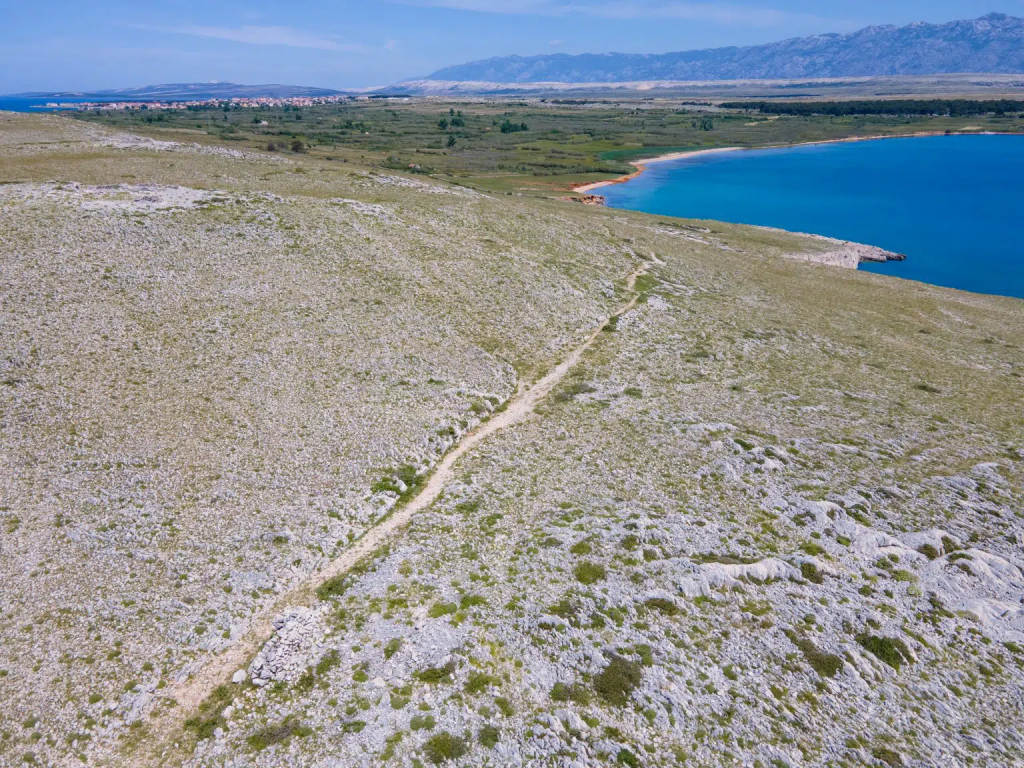
The path then continues and turns towards the north and to Velebit. It further descends towards the bay and the sandy beach in Stara Povljana. Through Povljansko polje, we reach the church of St. Martin, which was constructed way back during the fourteenth century, and Stara Povljana, where there was once an old settlement during the Middle Ages. At the very end of the trail, a spectacular scene awaits us - a strange but beautiful moon-like landscape, located in the area of the macadam path which connects
Povljana and the nearby fishing village of Smokvica, and stretches out into the beyond, as far as the eye can see.
www.pag-outdoor.com/trail/trail-81/


CLIMBING EXPERIENCES
Even the most “down-to-earth” people will want to shake off those proverbial shackles every once in a while, and they can easily do so by climbing the unreal rocks of Pag, in rugged landscapes shaped by harsh storms. For lovers of this type of recreation - climbing -
Croatia is already profiled as an extremely attractive destination, and the island of Pag is one of the most popular of all. On Beritnica beach, nature has arranged three large rocks in the shallows of the sea - this natural installation is an unforgettable sight and by far one of the most popular not only for climbing, but also for filming and taking pictures.

The spectacular Stogaj rock rises imposingly above the beach as if someone designed it precisely to beckon you to climb to the top. It’s no wonder that this is a favourite destination for climbers.
Stogaj offers almost seventy clearly marked routes over four parts for athletes and recreationists of all abilities. It is also suitable for beginners who can try their hand at an easy, shorter climb at a height of ten metres, and for those who are experienced climbers, it has the Scorpion and Spyder tours. Swimming in the crystal-clear sea below after climbing is an essential item to tick off the list, and something like this is definitely not to be missed.
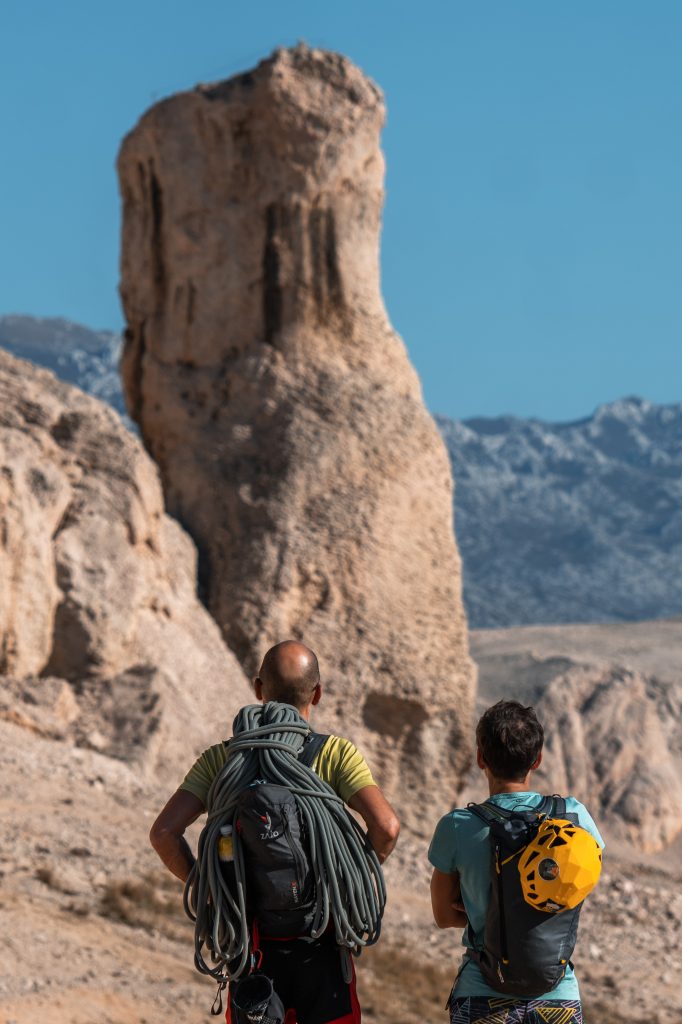



KAYAKING
Don’t miss another strong asset that the island of Pag boasts - kayaking! One of the more popular routes starts at Ručica beach, an inspiring setting for many film, music and fashion shoots, and moves towards the sandy cape of Sušac along the passage under the impressive rocks of Stogaj and Teplica.

It then allows you to paddle past long and spacious sandy beaches which are strung together like pearls, with occasional rest stops for some swimming implied. In the surroundings of this strange white karst landscape combined with the crystal clear blue sea lapping against it, rowing towards the opposite side of the Pag bay becomes an unforgettable experience with, among other things, a spectacular view of the Velebit mountain and what’s known as Paška vrata (the Pag Gate) the mysterious Gača cave and beaches the likes of which exist nowhere else on the planet.



CYCLING
Cycling, as one of the most popular activities, has been at “home” on the island of Pag for a very long time now. Today, there are more and more tourists who come to cycle. They aren’t only ecologically conscious people, but also consumers whose main motive for coming to a destination such as Pag is the diverse landscape and well-maintained biking trails. There is no fear when it comes to Pag, as there’s an offer for all types of cycling tourists!
This peculiar island which boasts endless cosmic beauty has a whole series of beautifully arranged trails for different profiles of passionate “pedalists”: from beginners to intermediate cyclists, up to true adventurers seated on two manually controlled wheels.

For example, the Path of St. Anthony in Novaljsko polje (the Novalja plain), as well as the which has the same name, is suitable for beginners and lovers of a lighter riding style. The Put Girenica and Povljanska blata routes are also right up that same alley. All instructions on the routes, mileage and ascents are available on the pag.outdoor website, and the same applies to the medium-demanding trail - The embrace of the stone and wind.

GRANFONDO PAG – Cycling on the Moon”
www.granfondopag.com
In short – what marathons are for runners, and what ironman is for triathletes, Granfondo is for cyclists. Competitors in the leading group are all peddling away, fighting for victory, those in the middle are attempting to achieve their best possible personal time, and the cyclists at the back are there primarily for overcoming the challenge of finishing such a demanding race (sometimes also to avoid the “cut off time”). Rather than racing against the other cyclists, the
Granfondo is a battle with oneself, and the length of the course successfully completed (about 100 kilometres!) is the greatest reward of all.
Reserve the date of October the 14th, 2023, for the fourth International Cycling Marathon “Granfondo Pag - Cycling on the Moon (85 kilometres), and the recreational race “Mini Granfondo” (35 kilometres) and ride through the unreal, lunar landscape of the island of Pag.



Photo: Pag Outdoor
The allure of Omiš - What not to miss when visiting the town on the Cetina river!
Let the sun rise over the Fortica fortress and set again on the Mirabela fortress - the former
pirate lookouts, and make sure to snap some enviably beautiful photos for your social media
feed!
Treat your palate to some local delights such as soparnik – a delicious dish made from
Swiss chard, white and red onions and of course - locally made olive oil.

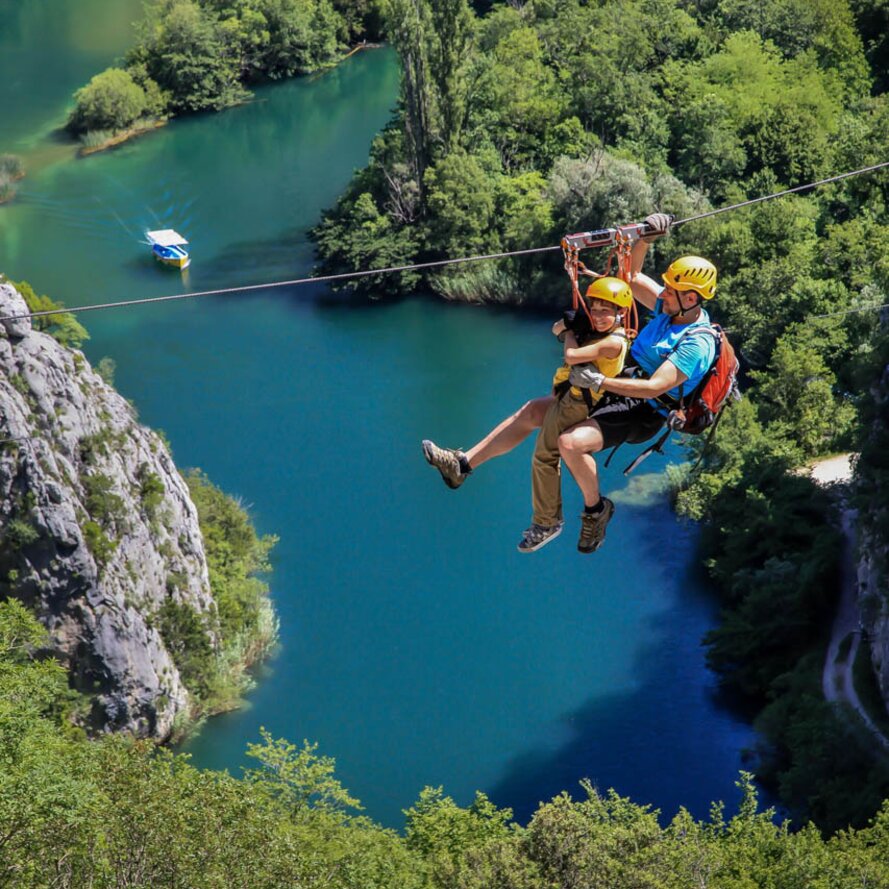
When your stomach is not only satisfied but also invigorated by this once rather heavy meal, which has now become a real gastronomic brand of this part of Dalmati, head to the canyon of the emerald green Cetina river - there you can walk, hike, run, climb, or enjoy some rafting, canoeing, and if you’re feeling brave, even try out the king of all adrenaline activities - the zip line.
Don’t forget to pay a visit to the nearby Radman mills, near which there is a hidden river
island better known as the island of love.
When you decide you’re getting a bit too hot, you can easily refresh yourself wonderfully by swimming in the stunning Cetina river, and if you prefer to explore the depths of the sea, dive into Vruja bay, which delights both professional divers and beginners alike.
If you’d prefer to stick to dry land, try your hand at a real competition - join in on one of the
Dalmatian trail leagues - ImberTrek or Mosor Grebbening and the Dalmacija Ultra Trail.

We do need to mention that you can't even say you've been to Croatia’s well known pirate
town without visiting at least one of the fishermans’ nights and at least one destination along
the beautiful Omiš Riviera (Stanići, Lokva, Mimice, Medići, Pisak…) You also need to listen
to at least one Dalmatian klapa music performance live. If you do decide to follow our
instructions, you’ll feel like a local from Omiš in no time.

More: visitomis.hr
The Kolan Municipality - A tasty world full of scents
In the very centre of the strange, moon-like island of Pag lies a place called Kolan - the
cradle of Pag’s famous cheese and lamb, which is also a perfect place for a versatile and
more active holiday.


Maybe just after reading our text, the idyllic Dalmatian towns of Kolan, Mandre and Kolanjski Gajac will become your new destinations with an authentic Mediterranean touch.
Kilometres of sandy and pebbled beaches being lapped by the calm waves of an
exceptionally clean sea will leave few people unimpressed, and you simply can't go wrong
with your choice - whether you choose Sveti Duh (Holy Spirit), Mandre, Rogoza, Girenica,
Gajac, Katarelac or Čista, undisturbed pleasure in the joys of the sea is absolutely
guaranteed.
These destinations will also delight kayak lovers - from Mandre, Girenica bay
and the Rogoza or Gajica beaches, kayakers can row out towards the open sea, and for a
more "quiet" rowing adventure, they might choose one of the beaches like Sveti Duh and
Čista.

There’s fun on offer for those who are always seeking adrenaline rushes - Due to the large
number of trails, the location of Kolanjsko polje is ideal for all lovers of off-road cycling. One
of the trails within the Pag Outdoor project - Put Girenice (Girenica Way), which will see
cyclists cycle along a macadam road to the Kolanjsko blato ornithological reserve - Rogoza,
starts there, and fans of these sorts of trails might like the 7.4 kilometre-long trail of
Kolanjsko polje, which is ideal for family hikes and a little bit of socialising.
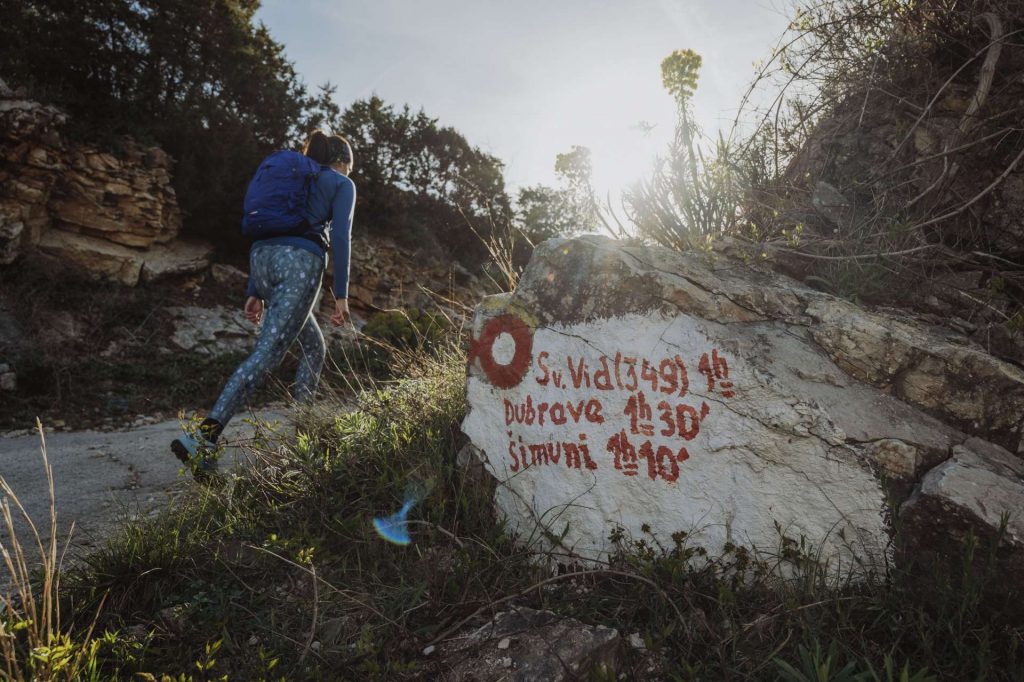
For the most daring lovers of active holidays, we recommend climbing to the highest peak of the island of Pag - Sv. Vid (348 metres), which offers an unforgettable view of numerous neighbouring islands and the greater part of the nearby Velebit National Park.

Take a trip to the gastronomic centre of the island of Pag - The special gastronomic offer is a
legitimate reason to visit Kolan all by itself - both because of the widely known Pag cheese
to which this is home, and because of the excellent restaurants and taverns there!

Don't miss those with the winners of the Pag autochthonous cuisine label on their menus, such as the Bonac and Figurica taverns and the Prtorić OPG (family farm), or the baked Pag lamb and sheep's curd desserts which almost made our heads spin.

If you are a die-hard gastronomad, visit Kolan, which celebrates Pag’s cheese and its kindred spirits - olive oil and wine.
More: tzkolan-mandre.com
GASTRONOMY OF SPLIT-DALMATIA COUNTY – AN INTERSECTION OF CULINARY
GASTRONOMY OF SPLIT-DALMATIA COUNTY – AN INTERSECTION OF CULINARY CULTURES FROM ALL OVER THE WORLD!
WHAT WOULD YOU SAY about a cuisine that combines sweet and sour, Greek and Roman, Byzantine and Venetian, all linked by a truly special ingredient – a quantum of stubborn, originally Dalmatian spite? Dalmatian cuisine will spoil your palates with homemade prosciutto and cheese, traditional fish stew (brodet) and thick fish soups, risottos and gnocchi seasoned with tasty dips, sea food stews; all rounded up with homemade olive oil, Mediterranean aromatic herbs and matched with wide range of exquisite homemade wines. If you want to give your palates a true adventure, it’s high time to taste these sensual dishes – true gastronomic ambassadors of Dalmatian cuisine!

A QUEEN CALLED PAŠTICADA. A true example of sweet-sour dish (see how Dalmatian cuisine is always a blend of extremes of some sort, unmatched by anyone?) is luxurious pašticada, gastro heritage of Venetia ad Byzantium, made even today for special occasions (due to its complex preparation) of beef aitchbone in wine, prosecco, vinegar, spices and vegetables. It is often accompanied by homemade gnocchi. Pašticada is so characteristic for this region that almost every household has its own way of preparing it; and it shares the throne with exquisite fish or meat dishes made under the baking lid! Namely, if you haven’t tried veal, lamb or octopus under the iron lid, which enables food to be cooked and roasted at the same time, from a gastronomic point of view, you haven’t even been to Dalmatia, so do not miss it! If you visit the islands, let the magic of small family restaurants overwhelms you.

There, apart form aforementioned Dalmatian classics, you can indulge in carefully prepared specialties like mutton baked on a juniper spear, which stimulates with resin wood aroma, or for example – crunchy vitalac - ancient dish made of lamb offal served in the “lamb capital”, the island of Brač, which is also a gastro connection to Greeks. Of course, if you prefer somewhat more modern gastronomic interpretations, there is a wide choice of modern gourmet oases – make yourself infatuated with octopus stew or burgers, monkfish medallions, cuttlefish with broad beans, shrimps carpaccio with olive dust and fig pearls, or an entire pot of shells, shrimps and pasta!

WINES WITH CHARACTER. True gastronomads and wine enthusiasts could draw you a map of Split-Dalmatia County in a second – according to areas where the best autochthonous wines are made! It’s a common knowledge for all who ever tried Kaštela’s crljenak – the darkest of all Dalmatia wines, or bogdanuša and plavac from Hvar and vugava from Vis - that in an elegant glass of wine one can discover a whole new world! With its classy barrique touch and mild tastes of blackberry, blueberry and cherry crljenak will most certainly comply with those in favor of fruity, bold wines. Although it was tied to Italian primitivo and Californian zinfandel, it has nothing of their sweetness and softness, it is a true - wine with a character!

Even Vienna Court could not resist Hvar’s bogdanuša, which was served only for holidays due to its elegance; while Vis’ vugava overwhelms with discrete aromas of peach, almond and orange! If you prefer red wines, enjoy in full, rounded, delicate woody taste of Hvar’s plavac mali, captivating like a nicely dressed girl walking along Hvar’s waterfront!

SOMETHING SWEET FOR THE END. What kind of a meal would it be without a good, tasty dessert? Beautiful rožata dates back to Venetian times, and it was considered a pride of Dalmatian desserts! It is cooked in a caramel coat, while a magic addition to a simple recipe that contains milk, eggs, vanilla and sugar is a scented rose liqueur! Split Cake will enchant you with rhapsodies of figs, almonds, walnuts, dates, raisins and rum, and eager Dalmatian housewives discovered that the dough and cream are made of even 10 eggs!

Simple and delicious paradižet is made throughout Dalmatia, just as omnipresent fritule, kroštule and doughnuts, most commonly served in Dalmatian hinterland. Islands have their own trumps as well, just look at the list of Croatian intangible heritage goods and you will find there Dol’s hrapošćuša cake resembling the very Brač’s karst and famous Starigrad’s paprenjak! Combine them with a few drops of tempting lavender or carob liqueurs and you have finalized one great (and very tasty!) Dalmatian adventure!

Foto: dalmatia.hr
Croatian and foreign influencers are set to discover the most attractive locations across Split-Dalmatia County over a four day period
1st - 4rd 2022.
As part of the #CentralDalmatiaPower marketing project, the Split-Dalmatia County Tourist Board is organising the ‘’First International Meeting of Tourist Influencers’’ as part of the launch of a brand new destination campaign. This particular campaign will, in all respects, be entirely different from all previous ones. Around thirty tourist influencers will be staying in Central Dalmatia from June the 1st to the 4th, 2022, in order to promote the beauty of this region in the digital world. The protagonists of this destination campaign are Croatian influencers Ella Dvornik Pearce and Goran Jović.

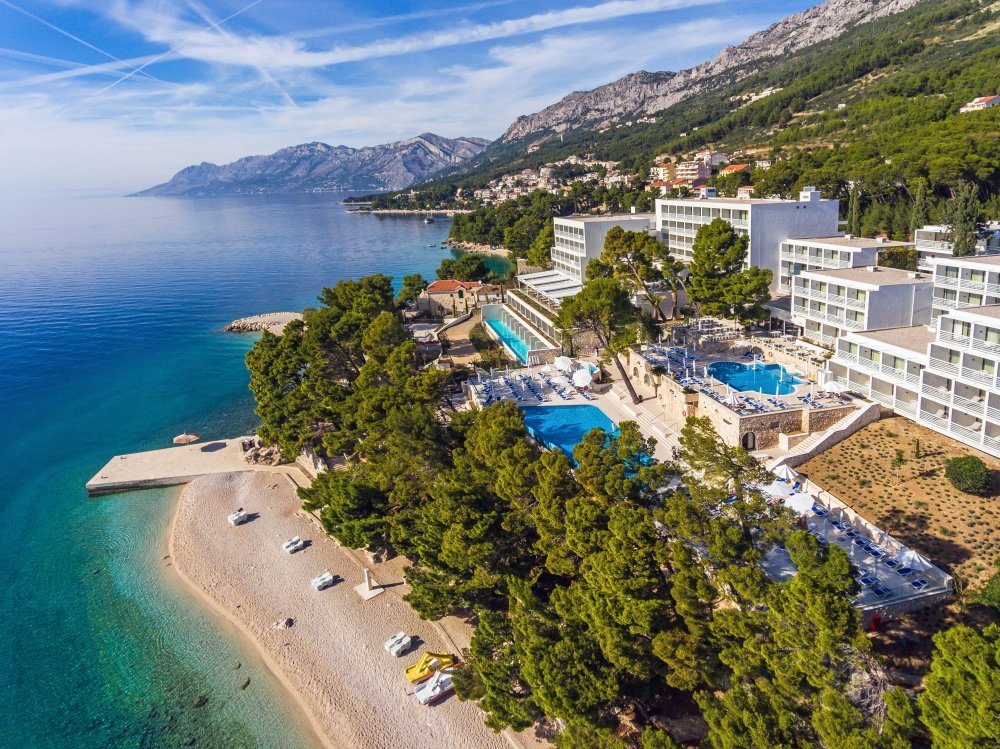
Thirty international and Croatian influencers will spend five days in Split-Dalmatia County
These influencers from both home and abroad are followed by millions of people on social media, and their potential reach is up to ten million people. The ambassadors of the campaign are the successful blogger Ella Dvornik Pearce and the famous Croatian travel writer Goran Jović. For three days, this group of Croatian and foreign tourist influencers will discover the most interesting attractions Split-Dalmatia County has to offer, and on social media, they’ll put Central Dalmatia in focus via various digital channels and attract some of the world's most important media publications.


THE ITINERARY OF THE FIRST INTERNATIONAL MEETING OF TOURIST INFLUENCERS IN SPLIT
Arrival in the morning / during the day at 1st of June, 2022, at Hotel Lav in Split
The 1st of June: (Split, Klis)
12:00 - 13:00 - A tour of Split with a guide, photography on Peristyle with Diocletian's Guard (Split Tourist Board)
14:30 - Lunch at Vidilica
16:30 - 18:00 - A break at the hotel
19:00 - Dinner and wine tasting with the finalists of Masterchef at Klis Fortress, socialising and getting better acquainted with historical unit of the Klis uskoks, as well as some archery

The 2nd of June: (A visit to the County Prefect and various county departments, a round table)
09:00 - The influencers will visit Split-Dalmatia County, talk with Prefect Blaženko Boban and his deputies, have a short question time and see a presentation of some major county projects
10:30 - 13:30 - A round table at Hotel Lav
"THE INFLUENCE OF TOURISM INFLUENCERS ON THE TOURISM INDUSTRY"
Programme:
A welcome speech by the organiser, the director of the Tourist Board of Split-Dalmatia County, Joško Stella, and the editor of the Croatia Hot Spots magazine, Maja Zlokić
1. #CentralDalmatiaPower - A presentation of the campaign and the project - The director of the Split-Dalmatia County Tourist Board, Joško Stella
2. The Croatian National Tourist Board (CNTB) - Influencer marketing
1. The influence of popular social cultures on the tourism industry - The head of the New Media Department at the Faculty of Political Science in Zagreb - Domagoj Bebić
2. The importance of influencer marketing in choosing a destination - Photographer, humanitarian and adventurer, Goran Jović
3. Influencers - A new generation of entrepreneurs, cooperation with the tourism industry - The most popular Croatian influencer, Ella Dvornik Pearce
4. A presentation of the #ShareIstria project - The director of the Istria County Tourist Board, Denis Ivošević
12:30 -13.30 - A round table
14:00 - Lunch at the hotel
17:00 - A visit to the WTA tournament, an exhibition match with tennis players 19:00 - A visit to the Biokovo Skywalk, Dinner



The 3rd of June: (Bol - Hvar)
09:00 – Ferry from Split – Supete, Supetar Bol transfer
11:00 - Photographing and searching for the stone of happiness on Zlatni rat (Golden horn) beach
12:00 - Wine tasting and catering at Stina winery
14:00 - Departure for Hvar
15:00 - Arrival in Hvar, followed by a tour of the Hvar Theatre and Arsenal
16:00- 19:00 - Free time
19:30 - Dinner and socialising at sunset at the Hvar Fortress, an overnight stay
The 4th of June: (The Dalmatian hinterland)
11:00 - Sinj, a tour of the Sinj Alka Museum, photography on Kamičak
13:00 - A visit to Imotski’s stunning Red and Blue Lakes




Dalmatia, a storytelling destination - The pirates of Omis once ruled most of the Adriatic Sea, instilling fear into all of the fleets of the time
Koja je razlika između gusara i pirata? Gdje se u Dalmaciji nalazi gusarska kula? Samo su neka od What is the difference between a pirate and what is known in Omis as a gusar? Where is the pirate tower in Dalmatia located? These are just some of the interesting questions to which the answers can be found in Omis. Licensed tourist guide Senka Vlahović is an interpreter of heritage in the Dalmatia Storytelling project and will be your companion through this cultural tour.

The Omis pirates once ruled the central part of the Adriatic Sea in one significant part of its history. Every fleet that sailed the sea back in those times greatly feared their attacks, and the Omis pirates especially ‘’loved’’ Venetian ships, which often ended up being in their way when heading off to their various trading destinations.

Omis - A cultural and historical centre
Whichever way you approach the old town of this city, from the direction of Split or Makarska, from the sea or the canyon of the river Cetina, I believe that, whether for the first time or after many previous arrivals, you will look in amazement and fascination at the rugged hills that tower over it. On one of these hills, the Omiš Dinara, high above the roofs of the houses, the tower of a former fortress stands out, which, unlike many fortifications on the Croatian coast, tells a slightly different story than you might expect.

The pirate fortress
There is a pirate fortress in Omis, and today, its tower dominates the view of the old part of town - Mirabela, or as it is also sometimes called, Peovici. Omis is surrounded by rugged and imposing hills, located at the entrance to the canyon and along the narrow coastal belt, with a small peninsula in front and a defensive canal that runs along the site of today's Adriatic Highway. It had and still has all of the predispositions of an impenetrable city. Therefore, it is not surprising that the people of Omis once dominated this part of the Adriatic Sea, and they did so for two hundred long years.
Mirabela was built at the beginning of the thirteenth century at a time when the Kačići princes ruled in Omiš. The tower offers a beautiful view of the nearby Brač Channel, the island of Brač and the river Cetina, and it served for military and defense purposes as an observatory and as a lighthouse.

Pirates, and the Omis gusari
Since mankind began walking the Earth, I would add sailing along waterways to that, in addition to various other forms of transportation, there have been wars, kidnappings and looting. The Croatian language knows two versions of the people who might engage in this sort of activity, pirates and what are locally referred to as ‘gusari’. The pirates attacked and plundered solely for their own benefit, while the ‘gusari’ also acted under the protection of the state under which they were, mainly to raise additional revenue for it, but also to destroy rival ships. At that time, the people of Omis were also called pirates and ‘gusari’, depending on which side recorded the events of the time and then interpreted the history. Likewise, it is important to emphasise that at that time no one could resist the looting and hijacking of other people's ships when given the opportunity to do so, so this activity was an integral part of medieval life at sea.
Princes - pirates
During the 12th and 13th centuries, Omis was a powerful naval power under the leadership of the Kačić princes. These exceptional sailors and warriors were brilliant shipbuilders, and they were also excellent merchants. Records show that with their famous rowing boats, the arrows of Omis, they knew how to sail to the shores of southern Italy, more precisely to Apulia. Although they sailed along a thin line between piracy and being Omis ‘gusari’, the Kačići princes and Omiš localsi primarily protected their area both on land and at sea. The Mirabela/Peovica military and defense tower, along with the remains of the castle, have been entered in the Register of Cultural Heritage of the Republic of Croatia as protected cultural heritage.

The pirate battle
Local pirates are brought back to life in the staged "Pirate Battle" which takes place every summer on the 18th of August near Omis, bringing the story of the Kačić princes, who ruled this heroic town on the Cetina back in the 12th and 13th centuries, and their 24-year-long successful fight against the Venetian invaders, into the modern day.
The challenge is to come face to face with the costumed descendants of the former Omis pirates, once the most feared warriors of the Mediterranean. It is an unseen attraction to enter their game, cross swords with them, and to escape from their captivity.
Anyone who would like to personally visit the place from which the Omis pirates once surveyed their surroundings with a watchful eye can find out more information by clicking the following link: http://www.omis.hr/…/Tvr%C4…/tabid/251/Default.aspx
Story and photos by: Senka Vlahovic, licensed tourist guide and heritage interpreter in the Dalmatia Storytelling project
Let Split’s museums take you on a journey through time
Croatia is recognised on the tourist map of Europe as a country with a lot of potential, but how can we best present the cultural heritage, historical, natural and all of the other sights that our country abounds in?

In Split-Dalmatia County, they found an innovative formula - the Dalmatia storytelling destination project, which revives characters steeped in heritage in museums and other important sites and creates thematic interpretive walks. This is a unique project in Croatia and Europe, within which 23 thematic interpretation walks were created and 16 heritage characters were revived.

Projekt nije namijenjen samo turistima, već i domaćim stanovništvu. Cilj projekta je kreirati turističke The project is intended for tourists, but also for locals, and works to create tourist experiences through the telling of authentic stories, which will be commercially available to the public through the county storytelling platform in the form of finished tourist products such as themed interpretation walks and costumed guides, storytelling trips and storytelling events. The aim of the project is to preserve and present Dalmatian cultural heritage and develop an offer encompassing year-round tourism in Split-Dalmatia County.

As part of the project activity of reviving heritage characters, costumed heritage interpreters (educated tourist guides or curators) will present the specifics of the museums and/or sites through the life stories of the people they’re dressed as to visitors. As such, they’ll make the stories authentic, picturesque, emotional, interactive and introduce visitors to an experience where together with the performers, they’ll immerse themselves in a kind of time machine from which they’ll emerge richer in knowledge and understanding towards the heritage story they were told and the place they visited.


As part of Dalmatia Storytelling, Split's museums will take you on a journey through time where you will experience all of this area’s sheer beauty and sights in full splendor, but also feel sadness, passion, joy, defiance, love - life drivers that lead to wars, and which sometimes direct the circumstances quite unexpectedly, differently, but always interestingly. Travelling through the paths of Split’s stories is a way to emotionally immerse yourself in Split and peek into the souls of its people.

BIRA MARULIĆ’S TOUR, A NOBLE FROM THE 16TH CENTURY AND THE SISTER OF MARKO MARULIĆ
INTERPRETER: GORANA GALIĆ
LOCATION: THE MUSEUM OF THE CITY OF SPLIT

Bira MaBira Marulić was a truly special woman, and with an interpretive walk with this noblewoman (played by a performer) through the Museum of the City of Split, you will learn many interesting things about Marko Marulić, the author of the historical epic - Judita. Visitors will be offered a view of Renaissance and humanistic Split within the permanent exhibition of the museum, located in the Gothic-Renaissance palace of the Papalić family. Back during the 16th century, it was a gathering place for the intellectual cream of the crop of the City of Split, led by the literary bard, Marko Marulić, who enjoyed a great, firm friendship with this family. Back then, of course, Bira wasn’t part of that "male world." She decided very early on that she would be ordained in a nearby Benedictine monastery next to Dioletian's Palace, but despite that, she remained closely associated with her brother Marko.


Stoga će vam interpretatorica koja utjelovljuje plemkinju Biru, sestru oca hrvatske književnosti Marka M
Therefore, the interpreter who embodies Bira the noblewoman, the sister of the father of Croatian literature Marko Marulić, but also a witness of that time, will present the way of life in Renaissance Split, providing her insight as a noblewoman, who witnessed very many turbulent historical and political events.
In her story, she points out the poor position of women at that time who were left as widows or without their fathers and brothers, and thus without the protection of the breadwinners, so they would often seek protection within the walls of the monastery of St. Benedict and the church of St. Euphemia, some of them becoming nuns.
THE MAGDA LUPIS TOUR - TORPEDO INVENTOR IVAN LUPIS’ RELATIVE
LOCATION: THE CROATIAN MARITIME MUSEUM IN SPLIT
INTERPRETER: PETRA BLAŽEVIĆ
If you want to experience the heritage of millennial Adriatic seafaring in an innovative way, join this interpretation tour with Petra Blažević, a curator disguised as a lady from the 19th century.
In going through the museum’s exhibit, you will be able to imagine what it would have been like to live in these exciting episodes of the past. Mrs. Magda Lupis will introduce you into this proverbial time machine and together you will embark on an exciting journey. Thanks to the method of costumed interpretive guidance, you will have the opportunity to gain a completely new experience by following the timeless Miss Magda, a cousin of the famed torpedo inventor Ivan Lupis.

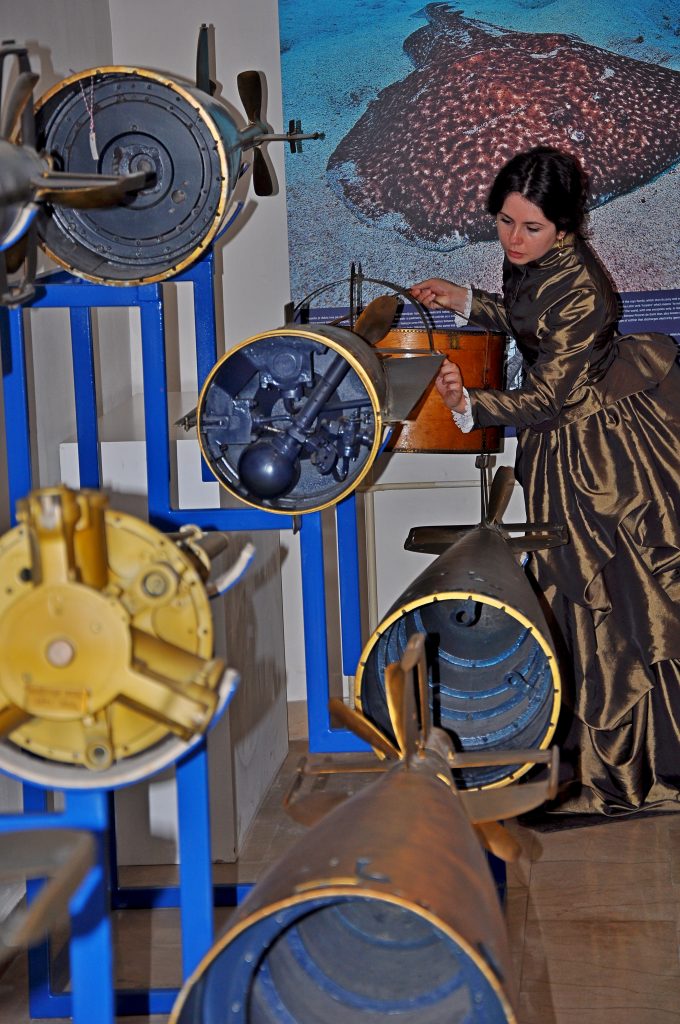

The whole tour revolves around one ordinary break that all travellers, including tourists themselves, experience while traveling to their various Adriatic destinations. This break, however, will be anything but ordinary. The year is 1866, and Magda is on a steamboat trip on the Gruž-Rijeka route and is currently preparing to visit the museum during a break between the arrival and departure of the ship from the Port of Split. If you want to experience Croatian history with the taste of salt in the company of a brave adventurous woman, feel her passion in discovering something new, and also hear interesting stories about the great invention of the torpedo, don’t miss out on time travelling 155 years back to Split's Gripe Fortress.

THE REVIVAL OF AUTHENTIC HISTORICAL AND LOVE STORIES FROM VELI VAROS
INTERPRETERS: BOŠKO PAPIĆ AND IVAN BARANOVIĆ
LOCATION: VELI VAROS Interpreters dressed as the famous Mayor of Split Ivo Tartaglia and local fisherman Roko, along with his beloved Cicibella, will take you for a walk through this picturesque suburb. You will learn all the interesting things about this part of Split, and also peek into human destinies, which wrap around these stories like a piece of very fine silk. The special feature of this tour is the discovery of what is not written in tourist guides, real life, woven with many emotions of the local population.
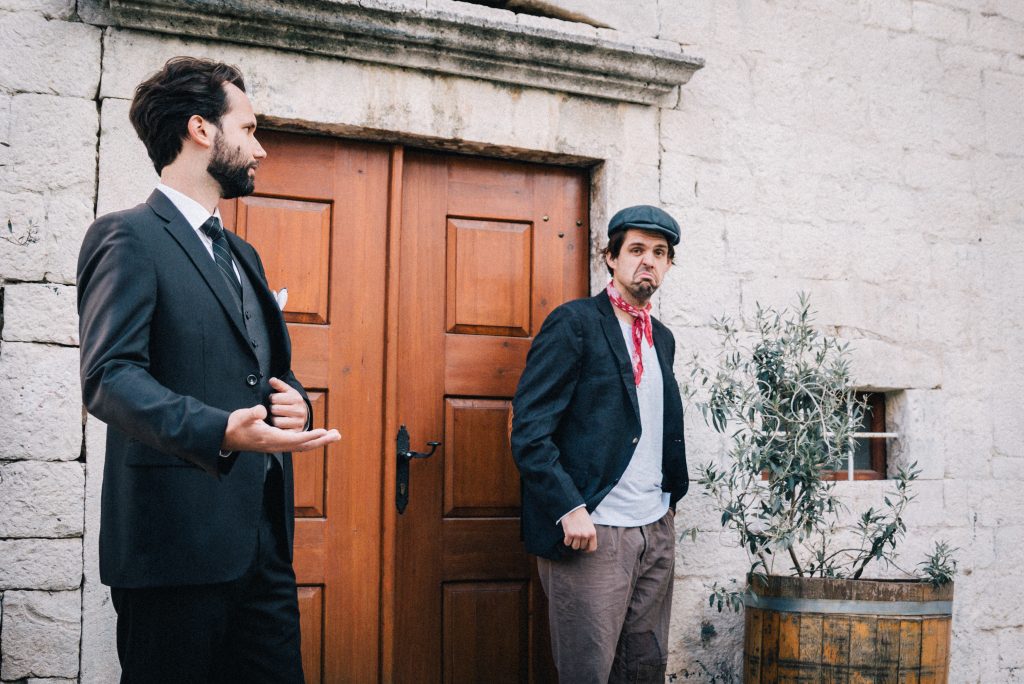

Posebnost ove ture je otkrivanje onoga što ne piše u turističkim vodičima, realnog života, istkanog The tour starts from Matejuška, a small fishing port where the inhabitants live from fishing, before turning to the south side of Varoš where the monastery of St. Francis from the 13th century can be found. Not far from the monastery at that time, the smell of sulfur could be strongly felt. Sulfur springs were discovered by Emperor Diocletian and springs were regularly used for healing, women also used to wash clothes at that same spring.

Walking through the small stone streets, visitors will discover what else the people of Split built in the 16th century in order to attempt to defend themselves from the Ottoman conquests, as well as what motives were the eternal inspiration of the famous painter Emanuel Vidović. Roko explains in his own way another peculiarity of Split - a specific sense of humor, prone to ridicule and sarcasm. Roko recounts what the game of hats looks like in moments of entertainment for the locals and how important wine is to them. Mayor Tartaglia presents local taverns as an indispensable part of the town's folklore and fraternity and explains the role of faith in the lives of the townspeople who always dream and hope for a better life. It must be noted that this particular tour isn’t currently adapted for people with disabilities.

THE STORY OF DON FRANE BULIĆ
VENUE: THE ARCHAEOLOGICAL MUSEUM OF SPLIT
INTERPRETER: NINO ŠVONJA
This costumed interpretive walk begins at the entrance to the museum where Don Frane Bulić, more precisely the performer in the modern day, talks about the history of the museum, with a well-known anecdote about the acquisition of the money for the construction of the building itself.

Kostimirana interpretacijska šetnja počinje na ulazu u Muzej gdje don Frane Bulić, odnosno interpretator, g
THE STORY OF DON FRANE BULIĆ
VENUE: THE ARCHAEOLOGICAL MUSEUM OF SPLIT
INTERPRETER: NINO ŠVONJA
This costumed interpretive walk begins at the entrance to the museum where Don Frane Bulić, more precisely the performer in the modern day, talks about the history of the museum, with a well-known anecdote about the acquisition of the money for the construction of the building itself.
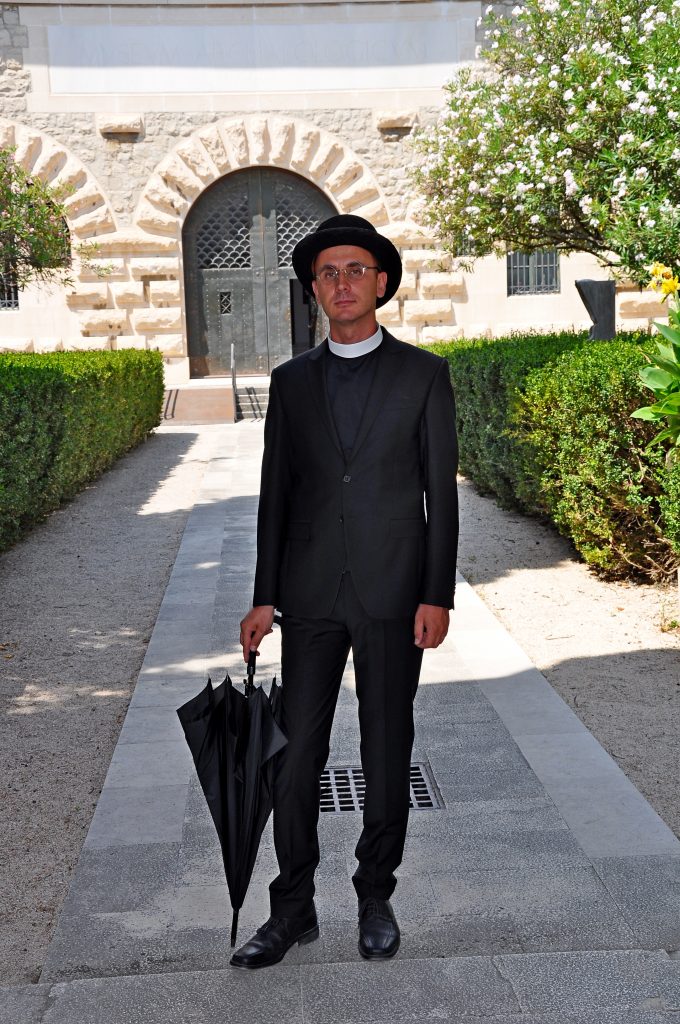
The lapidary can be visited during this tour, as can all of the stone monuments. Don Frane managed to purchase the sarcophagus of Valeri Dinent and his wife for the museum, the only unlooted sarcophagus in Salona (the modern day Solin). Don Frane mentions another sarcophagus - the Sarcophagus of the Good Shepherd. When the building was being constructed, he first had a sarcophagus erected, and only then did he erect a tower so that the sarcophagus could never be carried away.


INTERPRETATION TOPIC: OLGA MESTROVIC ON IVAN MESTROVIC
INTERPRETER: IRIS MARINOVIC
LOCATION: THE MESTROVIC GALLERY This tour is a reflection of Meštrović's family life through the memories of his wife, Olga Meštrović. The backbone of the thematic storytelling are the personal experiences and memories from the family life of the artist's wife who talks about the artist's profession and his work - sculptures which are in the permanent exhibition of the gallery.

The direction of this tour follows the chronology of events in their family and life. The tour begins in the garden with a conversation about the construction of a villa in Meje, with a look at the beautiful moments enjoyed as part of family life, in the central hall the theme is getting to know the artist and his wife, their love, their marriage and Olga's character, which is very much present in her husband’s stunning sculptures. More can be learned about their children and Meštrović's mother, and about the family habits and what was on the menu and on the dining table back then. On the upper floor, attention is drawn to the sculptures that reflect the physiognomy of Olga, as well as Meštrović himself.



INTERPRETATION TOPIC: RUŽA MEŠTROVIĆ AND THE STORY OF IVAN MEŠTROVIĆ
INTERPRETER: VESNA BULIĆ BAKETIĆ
LOCATION: THE MEŠTROVIĆ GALLERY IN SPLIT
Rosa Elizabeth Klein was Meštrović's first, and very artistically gifted wife, who skillfully mingled in the artistic and intellectual circles of various European capitals, which significantly helped the affirmation of Meštrović as an artist. The tour begins on the central plateau in the Gallery’s garden or under the porch, where visitors are introduced to the house’s history and architecture. What follows is a tour of Meštrović's works from the Viennese and London periods of his life.

The inner part of the tour starts from the room where one of Rosa’s more sensual, feminine sculptures is located. By the way, the Gallery also houses two works, which she made herself.
In the Secession exhibition room there is also a sculpture called Girl Singing, for which the model was Olga Klein, Rosa's youngest sister. Rosa talks about her childhood, youth and the circumstances of meeting a young Slavic sculpture student in the Austrian capital of Vienna, in a very interesting historical period.
In the central hall next to the Vestalka sculpture, stories about the life of artists across Europe follow. The sacral hall contains a theme that constantly runs through Meštrović's oeuvre, and is especially intense during the construction of the mausoleum of the Račić family down in Cavtat. These sculptures were created as a result of the artist’s sculptural maturity in the 1930s and the beginning of his family life. Here is where Rosa ends her story, passing away in 1942, with Meštrović continuing to live his life with his new family.




INTERPRETATION TOUR: MARKO UVODIĆ FROM SPLIT
INTERPRETER: HRVOJE COKARIĆ AND MARINA ABRAMOVIĆ
LOCATION: THE NATURAL HISTORY MUSEUM AND ZOO
The interpretation tour includes short stories by Marko Uvodić, published in his work Libar. The focus is on the coexistence of man and donkey in Split, at the beginning of the 20th century. In practice, this is a fifty-minute costumed interpretation of historical heritage, which begins with a walk in the fishing port of Matejuška, through Veli Varoš, and ends in the forest on Marjan, above the church of St. Nicholas. The interpreting team includes both an interpreter and a donkey.
The story relies more on research and the presentation of the coexistence of man and donkey in the Split of old, rather than on highlighting the historical locations of Veli Varoš and Marjan. The focus is placed on bringing the culture of the Split peasant closer, in the historical, political and cultural context of the then Split and of Europe as a whole.
The introduction refers to the then culture of the "little man" from a rather cynical point of view, avoiding the glorification of the local culture. This sort of interpretation is approached critically and satirically and the presentation is suitable for groups of 2 to 20 people. In addition to the standard fifty-minute interpretation, there is also a shortened version of 30 minutes, which ends at the first lookout, and a more extensive version of 70 minutes, which ends at the Split Zoo. The interpretation tour is suitable for people over the age of 10, but is not suitable for people with disabilities due to the relatively long walk involved in the tour.


Dalmatia, a storytelling destination - Get better acquainted with the glorious past of Central Dalmatia through antiquity
In every corner of Dalmatia, under every little stone, there is a story that has yet to be discovered…
Split-Dalmatia County can be met and better acquainted with in different ways, and the Dalmatia Storytelling project takes you on a journey through ancient times, proof of the tumultuous history of this region.


It was walked on by the feet of emperors, many soldiers of Roman legions, numerous pilgrims, and people who were looking for a better place to live, and that is why this area is a lure for tourists who like to travel from the present back in time, if just for a few moments.
The Dalmatia Storytelling destination project revives characters from Central Dalmatia’s rich past in museums and important heritage sites, and creates thematic interpretive walks. This is a unique project in Croatia and Europe, within which 23 thematic interpretation walks were created and 16 heritage characters were revived for the purpose.
Take in a breath of a time gone by...
Why go to Rome, when you can experience the history of the Romans here? Their mainstay was in Salona, an old Roman city which lies very close to Split. Salona isn’t merely referred to as an ancient gem, its historical material showcases and highlights all of the wisdom of the architecture of its time, as does the stunning Diocletian's Palace and the Tilurij (Tilurium) Roman camp.
In this article, we’re going to bring you three interpretive tours performed by licensed guides in the roles of Prisca, Kusija Valerija and Don Frane Bulić, who will take interested tourists on a journey deep into the past.

Interpretation tour: With the spirit of Prisca around the Palace
Much is known about the Emperor Diocletian, but much less is known about his life companion. Empress Prisca was a Roman who came from a patrician family. She lived with Diocletian in the palace of the same name, spending her life dedicated to him, conscientiously fulfilling all of the many obligations of a Roman wife, giving birth to his daughter, accompanying him to official dinners, and running the household within the palace.
The palace took a decade to construct and in 305 AD, it became inhabited and was constructed just eight kilometres from the then Roman metropolis of Salona. The palace was then deemed a true wonder, as it looked just like a Roman camp, while also doubling up as a luxury villa.
Accompanied by Empress Prisca, this tour takes you on a tour of the most important parts of the palace, the Silver and Iron Gates, the Peristyle, the Vestibule, the Cathedral - the former Emperor's Mausoleum… Jupiter's Temple. The most important part takes place on the Peristyle, the then ceremonial square, which connected the entrance to the Mausoleum, the entrance to Jupiter’s Temple, and to the south, the entrance to Diocletian's own apartment. Diocletian and Prisca appear on the balcony, he is adorned in a purple cloak, encrusted with jewels and pearls, modelled on the Eastern emperors, the Persians. He raises his right hand and shouts "Ave"!
Close your eyes and imagine these walls covered with a gilded mosaic, imagine the sculptures in the niches and the vaults. What splendor it was! Can you imagine that atmosphere? The morning sun rising from this Eastern opening and illuminating the opposite wall (which boasted a gilded mosaic), so that light is reflected all over the room?
Interpreter: Alemka Krivić


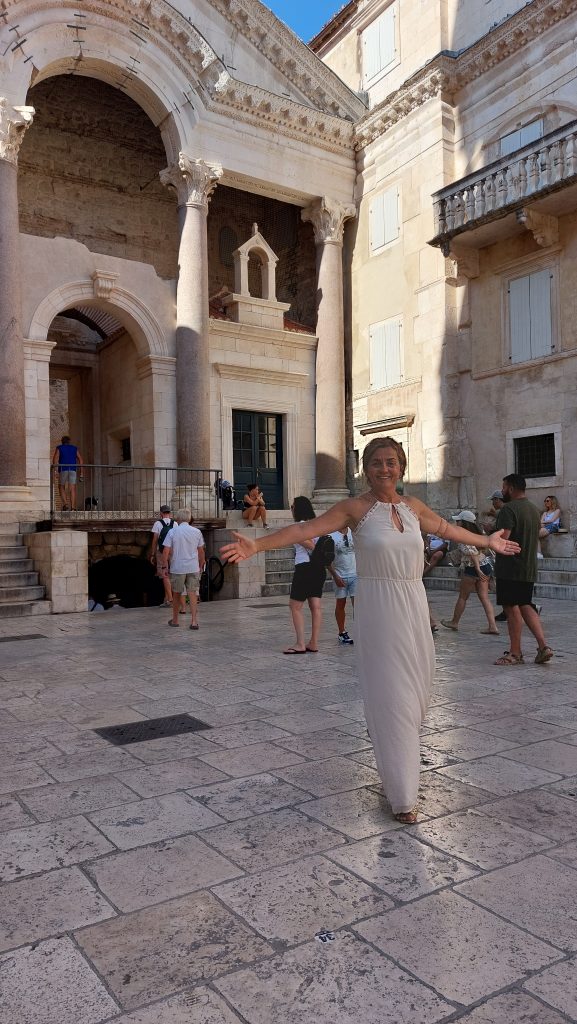

Interpretation Tour: The Story of Tilurium (Tilurij)
The Tilurium Roman legionary camp is located on the northeastern part of the plateau above Trilj, on the right bank of the river Cetina, and it was one of the most important military centres of the entire Roman province of Dalmatia - Camp VII of the Roman legions.
It covers an area of about 12 hectares, and today the ancient settlement is covered by the central part of the village of Gardun, which towers over Trilj. The camp is located in a strategically very important position, since the altitude dominates the surroundings and thus enables the control of communications across the river Cetina.
It has been systematically researched archaeologically since back in 1997. The excavations resulted in imposing remains of architecture and numerous movable discoveries, and two Roman tombstones were found in the neighbouring village of Vojnić. One belonged to Lucius Cusius Anharen, a freedman who died at just 20 years old, and on whose character the interpretive walk of the Museum of the Trilj Region in Trilj is based.
The project is performed by licensed guide Sanja Budić Leto who takes the role of Roman Kusija Valerija, who will lead interested tourists through the story of the camp and what each day looked like in this sort of life from a woman's perspective.
This storytelling tour will present the way life was lived back in those ancient times in an innovative and interesting way, as well as reveal the history. It will certainly be an unforgettable experience and a valuable source of new knowledge, both for tourists and for our fellow citizens.
Interpreter: Sanja Budić Leto

3. Interpretation tour: Don Frane Bulić
The costumed interpretive walk begins at the entrance to the Museum where don Frane Bulić, i.e. the performer, talks about the history of the Museum, with a well-known anecdote about the acquisition of money for the construction of the building. Don Frane was in an audience with the Emperor and told him about the problems of the obsolete building of the Museum.
The Emperor then wrote a receipt for the allocation of the necessary funds. But what matters is what stamp the Emperor placed on that document. If he put a small stamp, the Minister would certainly give some amount, but if he put a large one, then the Minister must give the full amount. When the Emperor wrote out that confirmation, he reached for the small seal, but Don Frane anticipated that he’d do so, and himself added a large seal.
The lapidary and stone monuments are also visited on this tour. Don Frane managed to purchase the sarcophagus of Valeri Dinent and his wife for the Museum, the only sarcophagus in Salona (today's Solin) to have avoided being stolen. Don Frane also mentions another sarcophagus - the Sarcophagus of the Good Shepherd. When the building was being constructed, he first had a sarcophagus erected, and only then did he erect a tower so that the sarcophagus couldn’t be taken away.
Interpreter: Nino Švonja




Dalmatia, a storytelling destination - An interpretation walk with Petar Hektorovic guides us through his life and deeds
This cultural-interpretive walk is carried out as part of the Dalmatia Storytelling destination project. It is dedicated to Petar Hektorović. It takes us back in time, deep into the past, and teaches us how the hand of fate brought Petar Hektorović to Tvrdalj, and how he wrote his ‘’stone book’’ in Tvrdalj. It then points out the reasons that prompted Hektorović to write his famous work “Fishing and Fishermen’s Talk’’, what his favourite cake was, what it was like to live in Stari Grad at the time of the plague, which Saint Roch (Sveti Rok) means to Stari Grad and what Petar’s role in all of that really was. It also tells us about his granddaughter Julija and the famous Tintoretto.


Interpretacijska tura o renesansnom pjesniku Petru Hektoroviću, priča je o osobi koju je iznjedrilo vrijeme
The interpretive tour of the Renaissance poet Petar Hektorović is the story of a person who was born during the awakening and renaissance on the island of Hvar. In a cycle of virtues and abilities, we will discover how he could swim strongly and resourcefully like a fish in their very own pond. Tvrdalj, the ‘’Fishing and Fishermen’s Talk’’ book, the Saint Roch Church and St. Peter the Martyr, is a thematic line that follows his life, actions and eventually - his death.
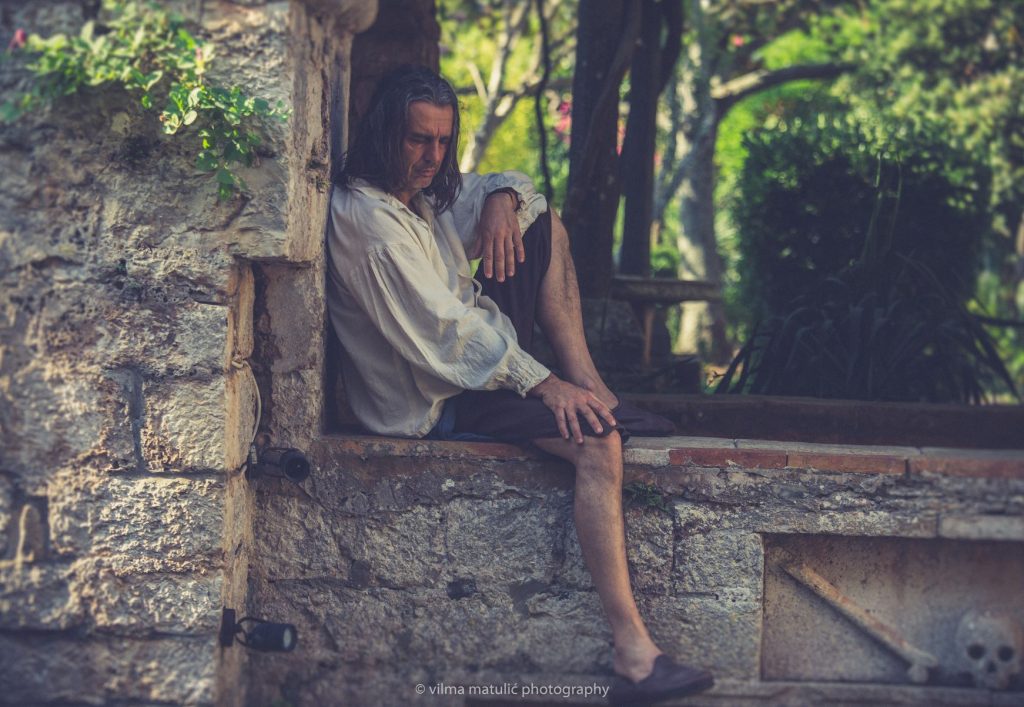

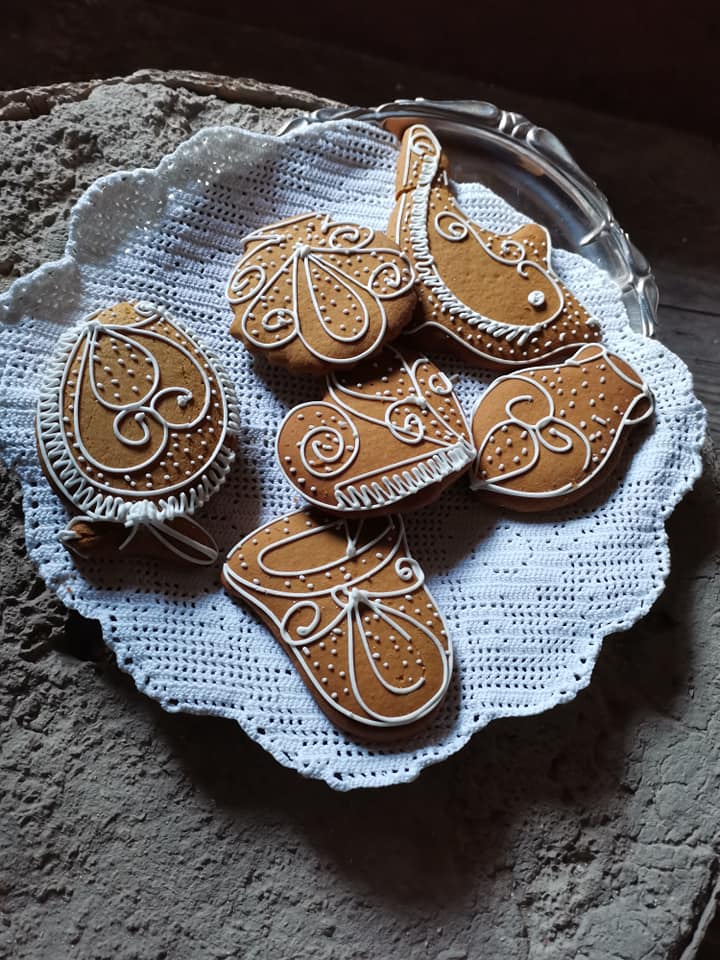
„
"At my Fortress, the fortress which adopted me" begins the story of the life of the famous Renaissance poet and nobleman Petar Hektorović. The saga reveals the details of the situation from life on the island of Hvar way back in the sixteenth century and how, under the scarlet cloak of this most unusual nobleman, and yet a true representative of the Renaissance period, the heart of a man who loved, understood and appreciated people regardless of their class and affiliation, beat strongly.



<!-- /* Font Definitions */ @font-face {font-family:"Cambria Math"; panose-1:2 4 5 3 5 4 6 3 2 4; mso-font-charset:1; mso-generic-font-family:roman; mso-font-format:other; mso-font-pitch:variable; mso-font-signature:0 0 0 0 0 0;} /* Style Definitions */ p.MsoNormal, li.MsoNormal, div.MsoNormal {mso-style-unhide:no; mso-style-qformat:yes; mso-style-parent:""; margin:0cm; margin-bottom:.0001pt; line-height:115%; mso-pagination:widow-orphan; font-size:11.0pt; font-family:"Arial","sans-serif"; mso-fareast-font-family:Arial;} p.normal, li.normal, div.normal {mso-style-name:normal; mso-style-unhide:no; mso-style-parent:""; margin:0cm; margin-bottom:.0001pt; line-height:115%; mso-pagination:widow-orphan; font-size:11.0pt; font-family:"Arial","sans-serif"; mso-fareast-font-family:Arial;} .MsoChpDefault {mso-style-type:export-only; mso-default-props:yes; mso-ascii-font-family:Arial; mso-fareast-font-family:Arial; mso-hansi-font-family:Arial; mso-bidi-font-family:Arial;} .MsoPapDefault {mso-style-type:export-only; line-height:115%;} @page Section1 {size:595.45pt 841.7pt; margin:72.0pt 72.0pt 72.0pt 72.0pt; mso-header-margin:36.0pt; mso-footer-margin:36.0pt; mso-page-numbers:1; mso-paper-source:0;} div.Section1 {page:Section1;} -->
Tvrdalj
The starting point of the storytelling tour about Petar Hektorović is the easily visible facade of the Tvrdalj summer house. In front of the building, guests get the impression of the size of the building, which is followed by a story about the no less famous poet. Through the main wooden door you enter the "portego", a lobby with barrel vaults, numerous antique chests and an attractive toilet area from back in the sixteenth century. Heading out on the south side, you enter the very heart of Tvrdalj, a real microcosm in which all God's beings are welcome.
Our host, the good spirit of Tvrdalj, teleports us into an oasis of peace and quiet, dominated by a real glittering emerald pond, framed by stone arcades and inscriptions from all over the world.
A view to the north reveals an interesting construction of a gazebo tower and a dovecote. From there we head over to the "glamorous" park. There sits an oval stone table and there is an interpretation of Hektorovic’s famous ‘’Fishing and Fishermen's Talk’’. In that very place and at that same old stone table, on clear days, Hektorović received friends, and enjoyed singing songs with them, feasting on Stari Grad peppercorns paired with a glass of prosecco. Heading from the park along the corridor to the west, we come to an ethnographic collection with exhibits of typical Hvar cuisine and a tavern where the Hektorović family used to gather together for a meal.
Saint Roch’s Church
This church is ideologically connected to the character and works of Petar Hektorović, who made the designs, financed the construction, and bequeathed the funds for its completion. He built this church and gave it as a gift to his city and his people in need, without whom he would not have completed his stone symphony, his Tvrdalj. Namely, back when the plague was ravaging Europe, people were influenced by St. Roch and sought help, so, Hektorović, being more noble than any other nobleman, decided to build a church with the name of that saint on his own property. In constructing Tvrdalj, Petar Hektorović built a strong friendship with the local people and in that way, he thanked them.
The Church of Saint Peter the Martyr
This church is the final resting place of Petar Hektorović and his mother Katarina. Above the main door of the church is an inscription about the unpleasant events which occurred back in 1571 when the marauding Ottomans attacked all of the major towns on the island of Hvar, including Petar’s own Tvrdalj in beautiful Stari Grad. The museum of the Dominican monastery, which is located within the church itself, preserves the unique Tintoretto altarpiece that once adorned the tomb and altar of the Hektorović family. The motif on the altarpiece "The Lamentation of Christ" hides an interesting fact within, and is therefore an unmissable point of interest for every single visitor.
This concludes the interpretive walk and the thematic line that follows and honorus the life, work and the death of Petar Hektorović.
Interpreter: Klaudija Gamulin

Dalmatia, a storytelling destination - Take the Adriatic Highway for an unforgettable storytelling road trip!
The Adriatic Highway is one of the most beautiful roads in the whole world. If you find yourself visiting Split-Dalmatia County, from whichever side you approach it, from the direction of Trogir or Makarska, from the sea or from the beautiful Dalmatian hinterland, you will be amazed and fascinated by the rugged coastal landscape, the azure blue Adriatic Sea in which islands are scattered like pearls... The richness of the past and the present intertwine along the entire coast and hinterland. On some of the hills, you will notice both towers and former forts each telling their own stories and the often tragic fates of well known local heroes…
With this article, we’re going to take you on an unforgettable "storytelling road trip" through three cultural interpretation walks, which are carried out as part of the Dalmatia Storytelling destination project, accompanied by licensed guides.


Sixteen reasons why I love Split
Interpreter: Nila Tudor
The tour called Sixteen reasons why I love Split tries to bring Split closer to those who know absolutely nothing about it through simple stories. The tour starts from the beginning of the Riva (Split’s waterfront), with a look at Pazar, which includes the unmissable local coffee and more which encompasses the Split mentality and the phenomenon of always wearing sunglasses, which is characteristic of Split - it’s one way to learn how to recognise who is a citizen of Split in another city, and who is a foreigner visiting Split.

On this tour you will learn how Split owes its name to a seemingly ordinary, fragile, but in fact powerful flower. This plant is called Spanish broom - and the Greek name of this plant is - Aspalathos. Spanish broom was once very widely used for making nets, ropes and as a textile raw material.
Our tour then continues to the model of the Palace, where the story of the construction of the Palace is presented, more about Emperor Diocletian can be learned, and then the tour continues through the cellars which reveal their secrets to us and narrate the continuation of the life of the Palace through many centuries past, all the way to the present day, with special reference to the reason as to why these cellars are so remarkably well preserved.

The easy walk continues on the Peristyle where the Sphinx tells us its story, and the mausoleum/church with its stunning bell tower evokes awe and a desire to visit in everyone who sees it. All of these elements are merged together and permeated into one truly fantastic natural stage - Split’s Peristyle. From the Peristyle, the tour continues in the direction of the Golden Gate with the story of Split during the Middle Ages, revealing some hidden details along the street, from its beginning to the end and telling a childhood story about when the Palace seemed like another world through the naive eyes of a child.


D
Arriving at the defensive courtyard, the church of St. Martin and below the Golden Gate.
We conclude and round off the tour by returning to, this time, the famous Dalmatian mentality that we can work to properly present through the characters of Gregory of Nin and Meštrović.

Stories and legends about the Omis pirates
Interpreter: Senka Vlahović
"Many of our visitors don’t know that once upon a time, access to the city of Omis was not only impossible but also life-threatening. How this situation came to be, quite understandably, will be asked by many people. Today, it is easily reached from all directions, by water - the sea and the river Cetina, but also by land - the Adriatic Highway and the canyon which leads down from the hinterland of Omis.
The answer to this question lies in stories from way back in the Middle Ages. During the time of the Dark Age, sandwiched between the hills and the sea, surrounded by the sparse karst soil, the people of Omis managed to survive as they knew how, so among other things, they worked as pirates.

Who were the princes of Omis, under whose leadership the brave Omis sailors controlled the navigation between Split and Dubrovnik for two hundred long years? How did they do it? What tactics did they use? Was piracy was a normal occurrence back then? What does the view from the pirate fort look like?
Find all of this out on a costumed city tour. Get much better acquainted with Omis in a new way by following in the footsteps of Omis’ pirates through the city streets accompanied by Princess Kačić.’’

The story of Mila Gojsalić
Interpreter: Nikolina Radmilo Pivčević
After only 30 minutes of pleasant driving through the picturesque Omis hinterland, we arrived in a small village called GATA. There, I was greeted by a brave young woman, Mila Gojasalić. August Senoa even wrote about her. Her figure was carved by Ivan Meštrović at the mouth of the river Cetina near Omis. Jakov Gotovac composed an opera bearing her name in 1951, but I actually got to meet her. Fearless, yet timid, an obedient daughter, in love and above all proud of her Poljica Republic.
Now her home is the Historical Museum of Poljica, where from today you can travel through time with her and discover the stories of that area, her life and the history she wrote. GATA-Omis has a new tourist offer to boast of at the Poljica Historical Museum, where Nikolina Radmilo Pivčević, a costumed heritage interpreter, revives the heritage character Mila Gojsalić.

Hidden island stories which will lead you to an unforgettable experience dominated by ancient times and full of legends
The idea behind the Dalmatia Storytelling destination is a unique storytelling platform that allows you to get better acquainted with unforgettable, authentic, emotional Croatian stories through something different and unusual.
In this edition of the article, we’re going to take you in search of Viver, a mythical creature that lives in the hidden caves of the mystical Brač village of Dol, a walk with the Renaissance poet Petar Hektorović, and to get to know the cultural heritage of Komiža - a wealth of fishing heritage.

"In search of Viver"
Interpreter: Ivana Gospodnetić
The inhabitants of Dol on Brač know about the mythical creature that hides in their caves, and they call him Viver. He can only be found in Dol, and if you are lucky, you might even be able to hear him calling.
About the village of Dol:
Dol belongs to a series of twelve old medieval settlements located in the interior of the island of Brač, sheltered at the end of a deep fertile valley, surrounded by steep hills topped with beautiful medieval churches, and at the foot of inexhaustible springs of water. Today it has about a hundred inhabitants living there, and at the very entrance to this small place lie breathtaking houses traditionally covered with stone slabs, as well as numerous caves made up of the grainy hrapućuša stones which were once human dwellings, which are currently used as shelters for cattle, places in which to keep firewood, a dwelling for pigeons, owls, but also Viver!
About the walk:
In an interpretive walk through the village, we’ll take you to meet the mythical creature that hides in the caves of Dol - Viver. One guide will embody many Dol locals who will take you to the past of this little village and directly to some of the legends and beliefs of its inhabitants.


This cultural-interpretive walk is carried out as part of the Dalmatia Storytelling destination project. It is dedicated to Petar Hektorović. It takes us back in time, deep into the past, and teaches us how the hand of fate brought Petar Hektorović to Tvrdalj, and how he wrote his ‘’stone book’’ in Tvrdalj. It then points out the reasons that prompted Hektorović to write his famous work “Fishing and Fishermen’s Talk’’, what his favourite cake was, what it was like to live in Stari Grad at the time of the plague, which Saint Roch (Sveti Rok) means to Stari Grad and what Petar’s role in all of that really was. It also tells us about his granddaughter Julija and the famous Tintoretto.
The interpretive tour of the Renaissance poet Petar Hektorović is the story of a person who was born during the awakening and renaissance on the island of Hvar. In a cycle of virtues and abilities, we will discover how he could swim strongly and resourcefully like a fish in their very own pond. Tvrdalj, the ‘’Fishing and Fishermen’s Talk’’ book, the Saint Roch Church and St. Peter the Martyr, is a thematic line that follows his life, actions and eventually - his death.
"At my Fortress, the fortress which adopted me" begins the story of the life of the famous Renaissance poet and nobleman Petar Hektorović. The saga reveals the details of the situation from life on the island of Hvar way back in the sixteenth century and how, under the scarlet cloak of this most unusual nobleman, and yet a true representative of the Renaissance period, the heart of a man who loved, understood and appreciated people regardless of their class and affiliation, beat strongly.
Tvrdalj
The starting point of the storytelling tour about Petar Hektorović is the easily visible facade of the Tvrdalj summer house. In front of the building, guests get the impression of the size of the building, which is followed by a story about the no less famous poet. Through the main wooden door you enter the "portego", a lobby with barrel vaults, numerous antique chests and an attractive toilet area from back in the sixteenth century. Heading out on the south side, you enter the very heart of Tvrdalj, a real microcosm in which all God's beings are welcome.
Our host, the good spirit of Tvrdalj, teleports us into an oasis of peace and quiet, dominated by a real glittering emerald pond, framed by stone arcades and inscriptions from all over the world.
A view to the north reveals an interesting construction of a gazebo tower and a dovecote. From there we head over to the "glamorous" park. There sits an oval stone table and there is an interpretation of Hektorovic’s famous ‘’Fishing and Fishermen's Talk’’. In that very place and at that same old stone table, on clear days, Hektorović received friends, and enjoyed singing songs with them, feasting on Stari Grad peppercorns paired with a glass of prosecco. Heading from the park along the corridor to the west, we come to an ethnographic collection with exhibits of typical Hvar cuisine and a tavern where the Hektorović family used to gather together for a meal.
Saint Roch’s Church
This church is ideologically connected to the character and works of Petar Hektorović, who made the designs, financed the construction, and bequeathed the funds for its completion. He built this church and gave it as a gift to his city and his people in need, without whom he would not have completed his stone symphony, his Tvrdalj. Namely, back when the plague was ravaging Europe, people were influenced by St. Roch and sought help, so, Hektorović, being more noble than any other nobleman, decided to build a church with the name of that saint on his own property. In constructing Tvrdalj, Petar Hektorović built a strong friendship with the local people and in that way, he thanked them.
The Church of Saint Peter the Martyr
This church is the final resting place of Petar Hektorović and his mother Katarina. Above the main door of the church is an inscription about the unpleasant events which occurred back in 1571 when the marauding Ottomans attacked all of the major towns on the island of Hvar, including Petar’s own Tvrdalj in beautiful Stari Grad. The museum of the Dominican monastery, which is located within the church itself, preserves the unique Tintoretto altarpiece that once adorned the tomb and altar of the Hektorović family. The motif on the altarpiece "The Lamentation of Christ" hides an interesting fact within, and is therefore an unmissable point of interest for every single visitor.
This concludes the interpretive walk and the thematic line that follows and honorus the life, work and the death of Petar Hektorović.
Interpreter: Klaudija Gamulin




Komiža’s fishing cultural heritage
Interpreter: Dora Čukušić
The Church of St. Mary is often referred to as the Church of Our Lady of the Pirates. It is located on the beach and was built throughout the sixteenth and seventeenth centuries. It is closely associated with the numerous legends of pirates and the fishing heritage of Komiža, the oldest fishing village in the entire Adriatic.
Throughout history, the islanders have struggled with many adversities including pirate attacks. There are a few legends about pirates and the origin of the name of this church, and one legend says that pirates once stole a picture of the Virgin Mary during the robbery of the church, but they couldn’t sail with her on board at all, managing only when they threw her off the ship.
Another legend says that they successfully sailed away with all of the treasure, but they were caught in a severe storm and they began to become unstuck and slowly sink, but the picture’s end was a little different...
As for the construction of the church, there are several variants, in one church document from local folk tales it is stated that a man from the Ivčević family was told three times in a dream that a picture of the Mother of God was somewhere on the shore and then he ended up discovering it in a small cave while fishing in the Komiža waves.
According to another story about the construction of the church, the Mother of God appeared to a fisherman while he was fishing and told him to go to the pastor and tell him to build a chapel for her. The pastor did not trust the fisherman at all until he read with his own eyes the miraculous inscription of Our Lady on the fisherman's back and then set out to build her the most beautiful church possible.
The Bishop of Hvar approved the construction of this church with a bull issued in Zadar back in 1513. Local fishermen's income from catching sardines, mackerel, anchovies and other species successfully supported the fraternity, the Parish church of St. Nicholas and the church of Our Lady of the Pirates, and the prayers addressed to the Mother of God ensured their protection and blessing, or so the people of Komiža believe.
A source of water flows beneath the church...
Thanks to having a very specific geological background, the island of Vis has its own drinking water which comes up from underground and just below this church lies one of the water sources that flows through the channels from the central altar through to the beautifully decorated well which boasts reliefs of biblical scenes out in the churchyard.

Follow the direction of an amazing island experience - VIA BRATTIA is waiting for you!


Despite the fact that it took a while as it was very carefully prepared, VIA BRATTIA, the circular tourist hiking trail of the island of Brač, has finally sprung into life and has opened up this island's sheer beauty to lovers of active holidays, as well as to those who plan to join that group of tourists.


Following two long years of joint work of all of Brač’s tourist boards together, the municipalities of Nerežišća and Pučišća, the Profunda Mountaineering Association, and with the co-financing of the Split-Dalmatia County Tourist Board, a new tourist attraction has been ‘’born’’ which will experience the most traffic during the pre- and post-season.
VIA BRATTIA, which is a massive 140 kilometres in length, has connected the whole island, its many exceptional locations, and a large number of small towns and local attractions.

The trail is intended for lovers of hiking, running, nature walks, mountain biking, it is suitable for recreationists and amateurs, but also for all those who want to get to know Brač and its unusual, stunning beauty in a slightly different way. The trail has clearly marked trails in both directions, and you can jump in and take the trail of your desire at any point.

You will be guided to all of the locations by a map and blue and white markers, and you’ll be able celebrate getting through each section with a stamp. With stamps attesting to your success, the end of the road will create a real picture, the coat of arms of the island of Brač, and in it the figure of St. George, the patron saint of this island in the scene of the slaying of the dragon.


VIA BRATTIA tells the truly amazing story of the island of Brač. It starts in Supetar, where you can walk through the streets where the famous sculptor Ivan Rendić, the father of modern Croatian sculpture, used to walk. With the help of a guide, you can start Rendić's tour and find out a lot about his works, but also about the attractions of Supetar, Leroj, the old cisterns, and how life functioned in a small Mediterranean town.



From Supetar you can then head to Mirca, and on the way you can stop in Sutivan, where you can relax in the Lemon Garden heritage hotel, or in many of the small apartments rented out as family accommodation. Then you’ll visit the catacombs, some of the few still in use today. Renting a bike and heading out on one of the island’s very many bike tours is also a top recommendation.



You can also cycle west in the direction of Bobovišća before descending to the sea where you will see an old fortress located on the very waterfront.

But that’s not the only story to be told by this small place. Vladimir Nazor spent his childhood and youth in Bobovšića, and his family house is still there, as is the symbolic tower he built. Next to it lies another, the Three Sisters, with three columns, built by Nazor back in 1937. On its pillars it bears three engraved letters I, O and A, the initials of the names of the sisters Irma, Olga and Amalia. Nazor cared for them throughout his entire life.

The next station is Ložišća, which many call one of the most autochthonous places on the island of Brač, best known for its stunning artistic work, the church bell tower made according to Rendić's designs, and lace carved in stone.

It is interesting how in the introductory part of the anthology series Naše malo misto (Our little place) by Miljenko Smoje, this very beautiful bell tower is shown. After that, it’s time to head down to Milna, a safe harbour for boaters, and a place completely facing the sea. Rade Harašić used to live here, a Milna native from whom Miljenko Smoje created poet Servantes’ character from the aforementioned Croatian cult series. Harašić's collection of paintings is still housed in Milna to this day.

Where you’re about to head off to now is one of the biggest attractions on all of Brač, through the hidden, turquoise bays of the southwest coast of Brač you will reach the Blaca Hermitage.

It is a monastery from back in the 16th century, founded by Glagolitic priests. You can only reach it on foot, so make sure to choose the time of day you take on the challenge carefully and be sure to bring plenty of water with you in the summer heat. Get ready for the goat trails, and the amazing views that await you at the end of this journey.

After that, you can head east, across the bay of Farska and to the town of Murvica where there are three excellent beaches.

Just above Murvica lies the Dragon’s cave, at 200 metres above sea level, which for centuries served as a sanctuary of the Poljica Glagolitic Catholics. They continued to live in it as hermit monks, and today, this astonishing cave is a top cultural location that you simply must see when visiting the island.
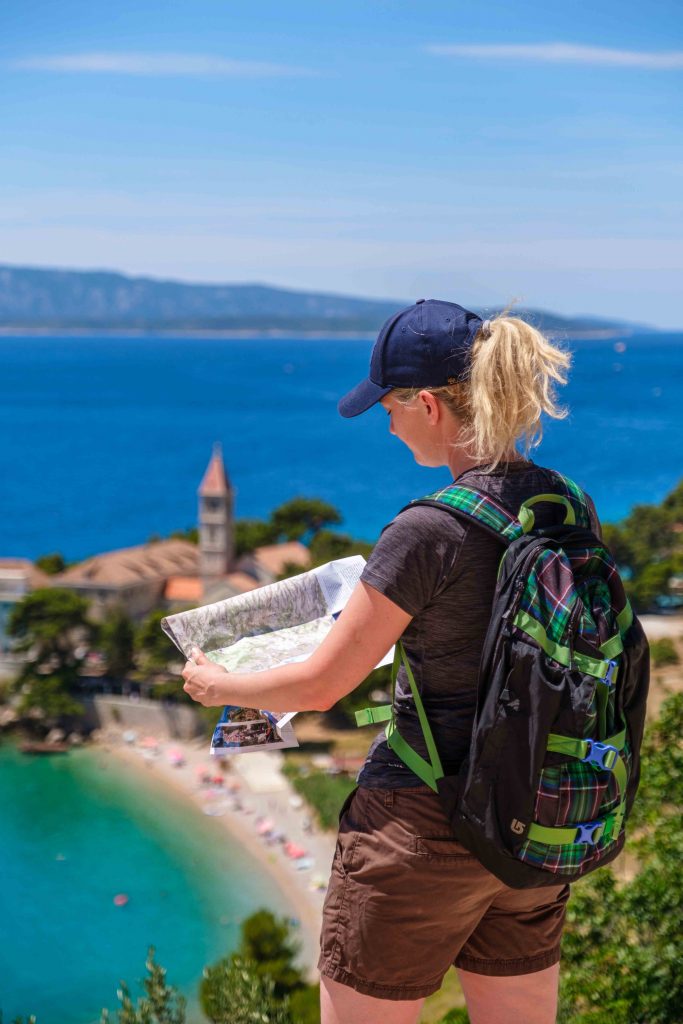
Then comes Bol and its trademark, one of the most beautiful beaches in the world, Zlatni rat (Golden horn), with its crystal clear sea and smooth white pebbles. When spending time in Bol, make sure to visit the Dominican monastery which is home to a library with rare copies of books.

There is also a recently reopened and renovated museum that houses a collection of incunabulum, church vestments and other interesting items. On the altar of the monastery church is the famous Tintoretto's fallen Virgin Mary holding a child which is from the 16th century, another amazing attraction from this part of the island.

Following Bol, you can ascend once again, high up into the hills in Podsmrčevik, to one of the five peasant hamlets with small stone houses, a monument and a symbol of the island’s former pastoral life.



From the hamlet you’ll then descend to the stone white village of Selca, where you can visit the beautiful cathedral on the square, as well as the famous busts and monuments dedicated to many famous people by the diligent stonemasons who come from this area.
From there, you can head down to the shoreline once again, more precisely to Sumartin, where you can visit the Franciscan monastery best known thanks to the poet and Franciscan Andrija Kačić-Miošić. Enjoy a refreshing swim in gorgeous Rasotica bay, then head to Povlja and visit the early Christian basilica located next to the parish church. Then comes the time to visit the famous Pučišća and the stonemasonry school, as well as the beautiful sandy bay of Lovrečina and the remains of the Basilica of St. Lawrence.

the way there lie Postira and the beautiful Villa na Mirju. Next to Postira lies the small town of Dol which has preserved its traditional architecture excellently. Be sure to try out their specialty while you’re there, roasted dormice and the famous hrapoćuša cake, a tasty calorific bomb made from an entire kilo of walnuts and the exact same amount of sugar.
On the way, you will come across a beautiful little place called Škrip which boasts the Museum of the Island of Brač, located in the Radojković tower which dates back to the 16th century. Be sure to stop by the beautiful Uja Museum, followed by a return to your starting point of Supetar.


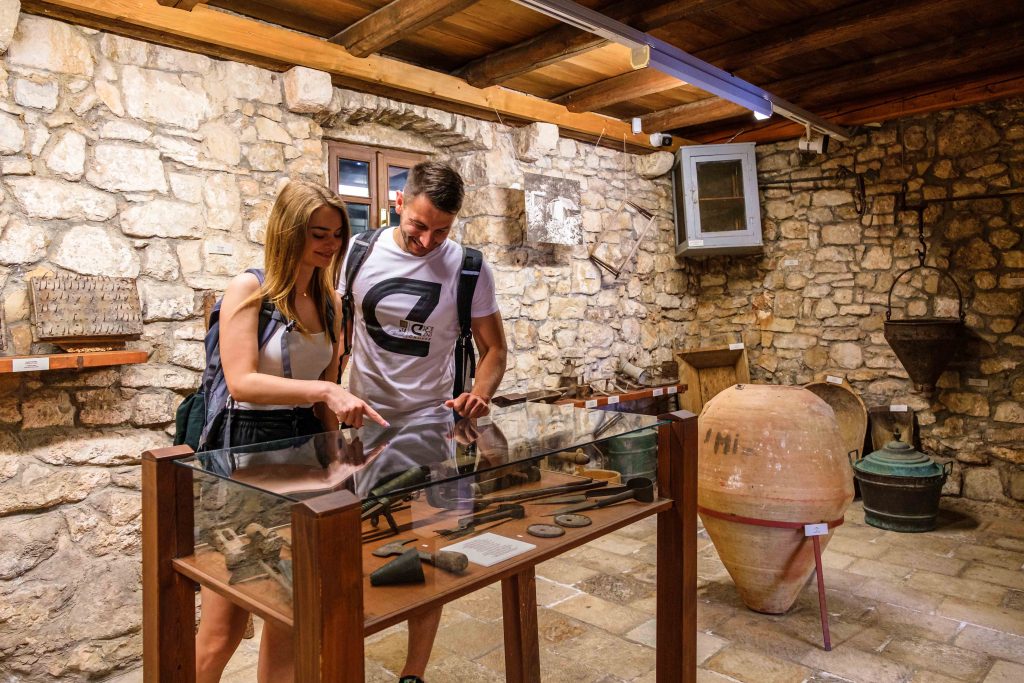
At the end, you will receive 12 stamps, each one representing each of the 12 points from this unique attraction in the Museum of the Blaca Hermitage, the Dragon's cave, the Dominican Monastery in Bol, Podsmrčevik, the Franciscan Monastery in the Church of St. Martin in Sumartin, the Early Christian Basilica in Povlja, the Stonemasonry School in Pučišća the Basilica of St. Lawrence, Vila na Mirju near Postira and the museum of the Island of Brač in Škrip.

The 11th seal is obtained in the church of St. Spyridon at the crossroads of ancient roads from Sutivan to Mirca, and the last in the church of St. Martin from the location of an extremely important strategic position and view of the sea route through the Split Gate to the Central Dalmatian islands of Hvar, Brac and Solta.

For all those who decide to take this amazing island walk, here are some important tips to be learned. Pedestrian sections would be desirable to do in such a way that sleep is provided in one of the more populated places near the route. The road map provided for the stamps can be downloaded from the Tourist Information Centre of the island, in Supetar, Sutivan, Milna, Bol, Postira, Pučišća, and in Sumartin. The fluid for the stamp should be carried on your person, as should sufficient amounts of water and food, especially in the summer months. And that would be it, VIA BRATTIA is waiting for you, so why not begin by heading in the direction of an amazing island experience?
MORE ABOUT LOCATIONS:
1 – MUSEUM BLACA DESERT

ABOUT LOCATIONS WITH THE STAMPS
1 – Hermitage Blaca Museum
The hermitage (monastery) was founded in the 16th century by the Glagolitic priests who come to Brač fleeding from Poljica before the Turks. Blaca can be reached from many directions, but always exclusively by foot. Blaca are really an exceptional monument of human work, with great historical, economic, artistic and scientific content.

2 – Dragon’s Cave
Dragon’s cave is a monument to the hermit-like monastic life of the Glagolitic priests from the 15th century. It is situated 200 m above the village Murvice, in the heart of Vidova Gora (mountain). Throughout the centuries it has served as the residence and sanctuary of Poljica Glagolitic priests fleeing before the Turkish invasion to continue their monastic life in the caves.

3 – Dominican Monastery In Bol
It was founded in 1475 in a location chosen for the Dominicans by the inhabitants of Bol, and confirmed by the Brač Duke Zacharia. The spiritual and cultural influence of the monastery was felt for centuries, not only in Bol but also the wider region. Aside from the museum in the monastery there is also a library with rare books and manuscripts.
4 – PODSMRČEVIK
Podsmrčevik is one of five hamlets settled in the inner part of the island, northwest of Selca. Today they are almost abandoned because their people settled in nearby settlements.
The oldest parts of this hamlet are characterized by small stone houses covered in stone slabs, using the dry-wall technique or built from hewn stone blocks, with enclosed gardens and stables.

5 – Franciscan Monastery And The Parish Church Of St. Martin In Sumartin
Fleeing the Turks Franciscan monks came with the settlers and founded Sumartin in the middle of the 17th century. The monastery is synonymous with the legendary poet and Franciscan monk Andrija Kačić-Miošić and today holds a private museum with valuable collection of artifacts. Next to the parish church also look for the footprint commemorating the “Footsteps of St. Martin de Tours”.

6 – Early Christian Basilica In Povlja
Many visitors come to Povlja to see the early Christian basilica on the grounds of the parish church. The remains of the Early Christian basilica date back from 5th and 6th centuries.
Many parts of this triple – naved basilica can be seen in their entirety, also as an area of the former baptistery. Povaljski prag and Povaljska listina, of great importance to Croatian history, also originated here.

7 – The Stonemason school in Pučišća
The Stonemason school began with its work in the remote 1909. This is the only school in the Republic of Croatia that educates the stone masons. Its work is based on the ancient Roman stone processing technology using hand crafted tools. It is recognized throughout the world and is being visited by innumerous visitors each year. The skill of hand stone processing using the old Roman tools nourished in the Stonemason school is protected by non-material cultural heritage of the Republic of Croatia.

8 – Lovrečina And The Basilica Of St. Lawrence
The Roman farm was built in Lovrečina bay, close to a water source and a fertile field. In the 5th century a Benedictine monastery was founded in the border area with the church dedicated to St. Lawrence, whose name has been preserved in the name of the bay. Lovrečina is the biggest sandy bay on the island Brač.

9 – Late Antique Villa On Mirje Near Postira
Mirje is situated among the two important centers on the Adriatic part of the province: Diocletian’s palace in Split and imperial quarries near Škrip, from which architectural stone for building the monumental palace was cut.
Numerous fragments of stone furniture confirmed the existence of a sacral building from the 6th century. The analysis of the discovered walls suggests that the complex was not built for the convent’s community, but that was in fact a later adaptation of the late antique villa with thermal complex.

10 – The Island Of Brač Museum In Škrip
The Island of Brač Museum, situated in Radojković Tower from the 16th century, is one of the Croatian most visited museums, annually visited by more than 15 000 people. Its foundations date back 1500 years A.C. In the lower floor of the Museum, there is a Roman Mausoleum where, according to the legend, rest Valerija and Priska – wife and daughter of the Roman emperor Diocletian. The Island of Brač Museum in Škrip is the place not to be missed when visiting Brač.

11 – St. Spiridon’s Church
Uniquely shaped small chapel at the crossroad of ancient roads from Sutivan to Mirca and former parish Donji Humac (16th century). Not far from the church there is a speleological location (pit), the only one in Sutivan area.

12 – Church of St.Martin
We don’t know exact time construction of the church of St.Martin, but shows early Romanesque style characteristics. On the facade of her annexed bell tower in the late 15th century. Simply stone facade on top of a brick distaff with a triangular pediment from the 14th century church is vaulted barrel vault without a flange, and the walls were broken down broad shallow niches. Above the altar is a Renaissance stone relief, workshop Firentinac, depicting St. Martin and the beggar on horseback.
photo: Hrvoje Gabrić, Robert Barilla, Alan Čaplar, archive TB Brač island
Marulić's Split – A great 500th anniversary of Judita
Today, on 22nd April, we celebrate Croatian Book Day by remembering Marko Marulić, the author of the epic poem Judita (Judith), one of the most significant Croatian literary works that he finished writing in Split on an exact date back in 1501.
On the occasion of the 500th anniversary of the publishing of Judita, the Croatian Parliament announced that 2021 will be "The Year of Mark Marulić." To celebrate the occasion, the Dalmatia – Storytelling Destination Project, The City Museum of Split, in cooperation with storytelling guide Gorana Galić designed a costume storytelling tour featuring Bira Marulić. Simultaneously, another storyteller, Nataša Bulić, leads a storytelling tour named Following the steps of Marko Marulić.
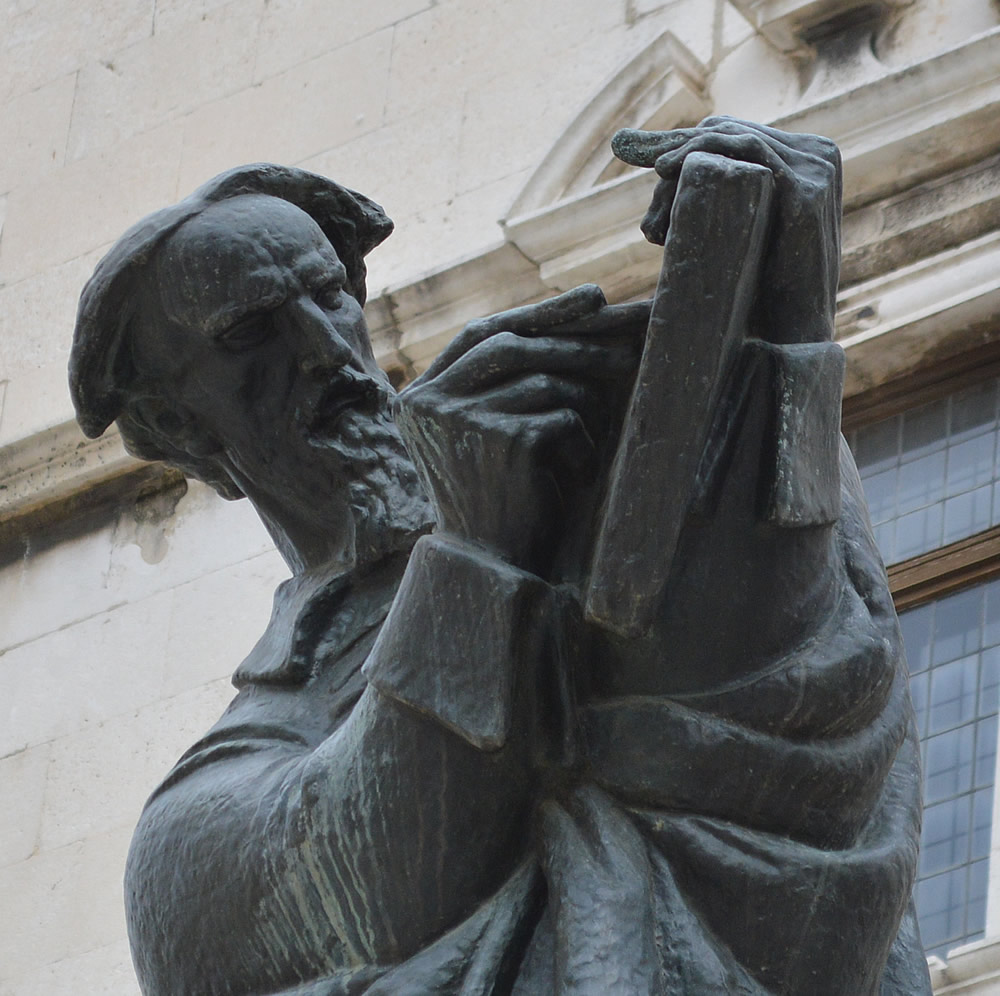
For Marko Marulić – one of the greatest Croatian writers - Split was a treasure trove of inspiration.
A poet, writer, and the father of Croatian literature are just a few synonyms for this great man, the guardian of Split’s heritage and one of the most prominent citizens of this town. While he grew into one of the most reputable humanists and philosophers during his stay in Venice, his life in Split awoke his poetic soul. The beauties of this Renaissance town were his eternal muse. Antiquities, Renaissance palaces, and ships arriving in Split's harbor from all over the world enriched his soul with new discoveries and experiences. They say that spirituality is one of the greatest virtues of humankind. For Marulić, the sense of humor of Split residents was a source of inspiration for his satiric poetry. As young noblewomen from Split adored his playful spirit, he also “composed” love sonnets inspired by their beauty.

He is the author of the first tourist guide through Split that emphasized the beauty of Peristyl. However, there is also a darker side to his work. As his city was exposed to a threat of the Ottoman Invasion, he contemplates the true freedom that resides in the human heart. He was especially inspired by Judita, a Biblical character of a widow fighting for Betulia. He named his masterpiece from the 16th century after her. Also, he wrote this epic poem in Split dialect to bring Judith closer to his fellow citizens. Interestingly, he coined a new term – psychology – that he uses in his verses for the first time in history. The statue of Marko Marulić, sculpted by the famous sculptor Ivan Meštrović, stands on Voćni trg (a square in Split), reminding us of the importance of preserving personal freedom.

A storytelling walk – Following the steps of Marko Marulić
This storytelling walk will take the participants to places where Marulić found his inspiration and felt a whole spectrum of emotions. This is a 60-minute walk starting in the old city nucleus, near the Diocletian's Palace and picturesque squares. The starting point is in front of the Marulić family palace. Then, it leads us to the historic trg Svetog Lovre, today popularly known as Pjaca, where once Venetian authorities resided. The walk ends on the famous Split's Peristyl, once a center of the Diocletian's Palace and an everflowing source of inspiration for Marulić. This tour is also suitable for the elderly. Please visit www.ichtisonline.com for more information.

Exhibition announcement of "Judita 500" exhibition on the occasion of the 500th anniversary of the first printed edition of Judita
The City Museum of Split, in cooperation with Marulianum – The center for studying Marko Marulić and his humanist circles and the City Library Marko Marulić, under the auspices of the City of Split, organizes an exhibition dedicated to Marulov ep (Marul's epic poem) Judita 500. For the first time, the visitors will get a chance to see the first four out of five initial editions of Judita, published in Split in the 16th and 17th centuries – in 1521, 1522, 1586, and 1627. Also, a reproduction of the 3rd edition from 1523, from the State Library in München, will be exhibited.
At the moment, the event has been postponed due to epidemiological reasons.
Please visit https://www.mgst.net/naslovnica/najava-izlozbe-judita-500/ for more information.
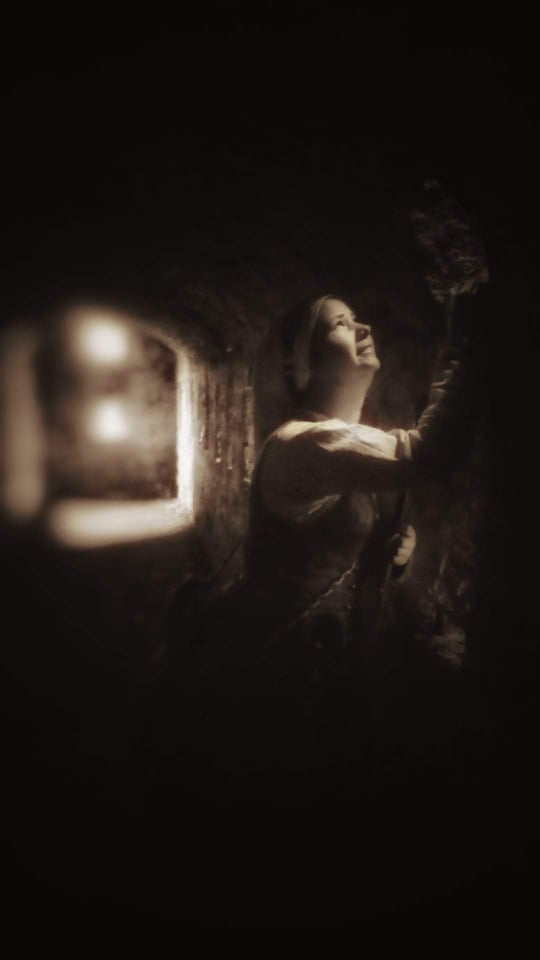
A story about a revived historical personality - Bira (Elvira) Marulić
The City Museum of Split is located in the northeastern part of Diocletian's Palace, in the Renaissance-Gothic palace of the Papalić family. Its courtyard, loggia, well, and ceremonial hall are considered one of Split's most beautiful cultural monuments. We will introduce you to the exhibits of the Museum in the Museum Lobby and tell you a story of one of the most famous Croatian philosophers, writers, and the father of Croatian literature, Marko Marulić. Already in the 15th century, the owner of the palace, nobleman Papalić and Marko Marulić collected and studied ancient texts from Salona (modern-day Solin), imbedded in the palace walls.
The walk continues to the Gothic ceremonial hall on the first floor, where one can learn in detail about the life of Marko Marulić, his source of inspiration, and the work of his fellow humanists. A critical figure in Marko Marulić's circles was his sister Bira. Renaissance women had two options – to marry or to join a religious order. Bira decided to join the Benedictine order sisters and spend the rest of her life in a convent near the Diocletian's Palace. Marko Marulić dedicated many of his works to his sister and other nuns. One of them is Anka Satira. The texts reveal that Bira was one of the first educated nuns. Her brother Marko wrote poems for them in Croatian variation of his satire. Marko Marulić was so close to his sister that he left behind a Gospel that he illustrated for her. The storytellers tell a story about Marko Marulić, Judita, Renaissance Split, and the Ottoman Invasion through the eyes of his sister Bira.
From the Gothic hall, the tour continues to the terrace where emblems of Split's aristocratic families are preserved. Visitors will learn about the ways of living in "the most beautiful city in the world" and interesting facts about the status and activities of noblemen.
The tour ends in the magazine located in the basement of the palace. Since Split was exposed to a constant threat of the Ottoman siege in the 15th and 16th centuries, it is also worth hearing a story about the war with Turks and the heroic defense of Split.

DALMATIA – STORYTELLING DESTINATION
Revival of storytelling in museums and institutions dedicated to preserving cultural heritage is a unique project in Croatia and Europe. In Dalmatia, as a storytelling destination, 14 characters of the area's rich heritage have been revived. In addition to this project, 23 themed tours have been created. This project, intended for tourists and the local population, is focused on providing authentic experiences of cultural heritage through storytelling. These commercial guided tours will be available through the County's storytelling platform that offers storytelling tours led by knowledgeable and certified guides wearing costumes. The project aims to preserve and publicize Dalmatian cultural heritage and create attractive 365 tourist offers in Splitsko–Dalmatinska County.
Storytelling guides:
Storytelling walk – Following the steps of Marko Mrulić: Nataša Bulić
A story about a revived historical personality - Bira (Elvira) Marulić: Gorana Galić
Photo credits: Dalmatia – Storytelling destination, the archive of storytelling guides
DALMATIA – A STORYTELLING DESTINATION This is a story about Split, citizens of Split and their battles throughout history

For centuries, the beautiful Mediterranean city of Split, located between the Marjan Hill and the Adriatic Sea, has attracted visitors from all over the world. Here they discover monuments from times long-gone, touch the thumb of Grgur Ninski and explore cellars of Diocletian's Palace, marveling at this magnificent architectural monument.

They also enjoy Marjan, "the lungs of the city," creating beautiful moments for their treasure boxes of memories. However, the story of this glorious city can be told in a completely different way: through the history of the Jewish community in Split with explorers, artists and mayors that will soon find their place in new specialized storytelling tours.
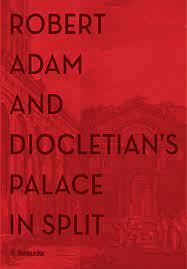
The Story of Robert Adam Discovering His Own Style
Diocletian's Palace in Split has always attracted international travelers, writers, historians, architects, and archaeologists curious about one of the best-preserved antique monuments in the world. Many of them tried to describe it but only the rare British architect of Scottish origin managed to do so, Robert Adam, who was mesmerized by Roman architecture and began to explore antique architectural structures. As he was intrigued by Emperor Diocletian and "the Emperor's monumental villa" in Split, he decided to visit this monumental city and learn more about the private architecture of ancient Romans. His first glimpse of the town was from the sea: "The moment you sail in between the two capes extending into the sea that form a large bay and a friendly harbor, you will see the remains of the walls facing the sea and a long arcade of the Emperor's Palace, a modern fortress, a lazaretto and towers located within the walls as well as one of the ancient temples. The urban structures are perfectly harmonized with the surrounding hills creating beautiful scenery. Upon his return to London, Adam spent 6 years preparing etchings for 61 etching plates. He published the book Ruins of the Palace of Emperor Diocletian at Spalato in Dalmatia in 1764.
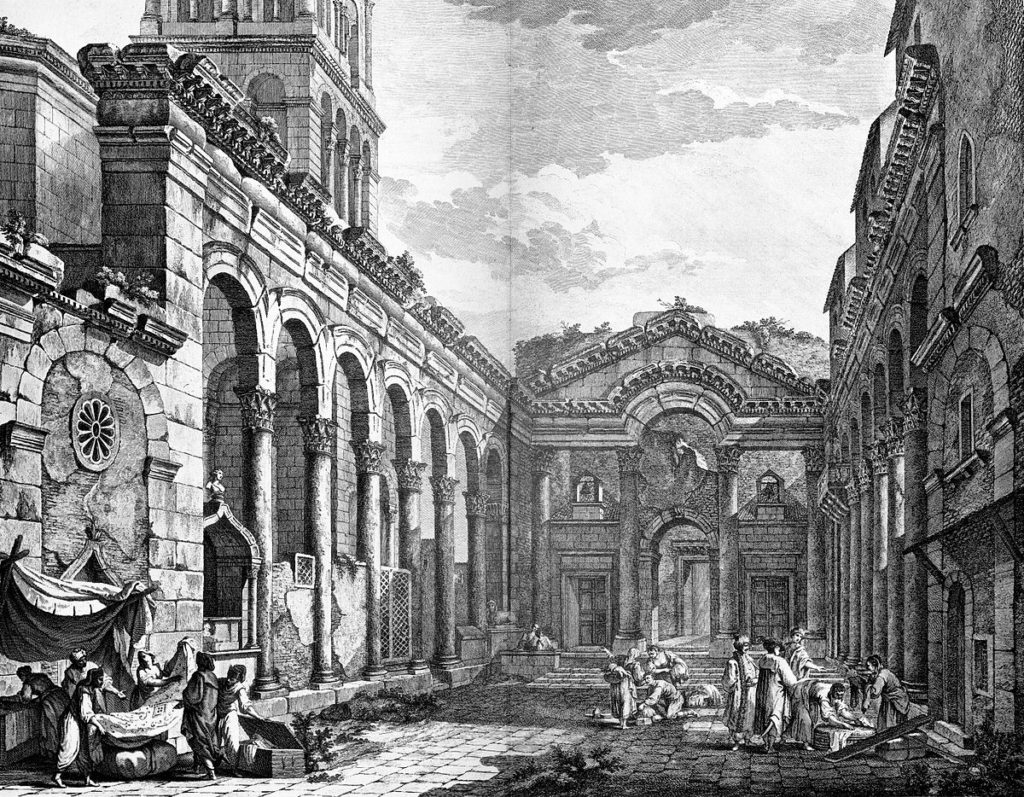
Adam's visit to Split and the Diocletian's Palace influenced his work and in part inspired his own style of interior decoration, named "Adam's style." He was deeply influenced by ancient civilizations. His experience of the Split's architectural masterpiece, especially the southern façade of the Diocletian's Palace, is visible on the Register House in Edinburgh and in the orangery of the Bowood House in Wiltshire, known as the Diocletian Wing. Simultaneously, the Adelphi Buildings on the Thames in London represent his interpretation of the whole Diocletian Palace.
Robert Adam was so astonished by Peristyle, a half capital from Diocletian's Palace that he used it to decorate the façade of a building located on St James' Square in London. His architectural style was so strongly influenced by Split's ancient monuments that he included the sketch of the entire capital in his book The Works in Architecture of Robert and James Adam.
Jewish Heritage in Split

Jews in Split is the name of a storytelling tour that will take you all the way back to ancient times. Jews have been living in Split ever since the times of Emperor Diocletian, and stonecutters' symbols on the walls of the Palace testify to their presence in the Palace. A Jewish cemetery and decorated menorahs, Jewish candleholders from the 3rd century tell us a story about their lives in Salona (today's Solin).

Although persecution has been the major part of the history of Jewish people, they were welcomed in Split thanks to their excellent multilingual and trade skills. Daniel Rodrigues, a Jewish community member in Split anda tradesman,left the most significant trace.In honor of his contribution to the evolution of the city of Split, a street was named after him - Rodrigina Street that was once inhabited by Jews exclusively. Next to it, in Židovski prolaz (Jewish passage), one of the oldest still active synagogues in Europe and the only one in Split found its home. It was built in the 16th century. Well-preserved, it tells a story of the influence of the community up to the 18th century.

Today, the Jewish community of Split has approximately a hundred members that occasionally organize exhibitions and lectures. Work hours are from 10 a.m. to 2 p.m., on work days.

The Mayors of Split
A storytelling tour named The Mayors of Split tells a story of visionaries that have shaped Split as it is today. The guided tour starts on Prokurative with a tale of Antonio Bajamonti, a medical doctor and an adored mayor of Split for almost twenty years. He turned a neglected and poor varošica (a small town) into a modern Mediterranean city. He renovated the Roman aqueduct, introduced gas mantles, and built the Bajamonti Theatre.
The tour continues on Splitska Riva, where the scent of sulfur can be felt due to the sewage collectors constructed thanks to the mayor Grabić.
While strolling down the Riva, the scent of sulfur reminds us of "sulfur spas," and "furešti" (a slang expression for foreigners) who should learn about the mayor Grabić, thanks to whom today’s Riva smells only of sulfur.
Today's King Zvonimir Street was once known as Dr. Ivo Tartaglie Street, named after the favorite mayor of citizens of Split, a lawyer, politician, and painter. Thanks to his efforts, electricity supply was introduced in Split as well as it was connected to the mainland through Lički railway constructed in 1925. You will get a chance to find out more about this street that you will reach from the Riva.
This storytelling tour ends near Koteks, the first shopping center in ONE communist country. There, the participants will get a chance to find out more about the mayors of Split during the most significant city’s industrial-construction expansion and about the famous Mediterranean Games.

World War Two in Split
This is a story about the citizens of Split and their struggles during the Second World War. A war means destruction, pain, and suffering, and Split was no exception during the Second World War. The terrific bombardment of Split destroyed almost 20% of homes. However, innocent victims (citizens of the town) are those who suffered the most extensive injustice.

Tyranny was a form of rule of the new government that imposed new restrictions on living. Every new day brought further instability, sometimes in the form of price inflation, sometimes in the form of scarcity (of all essential goods) and sometimes in the form of the bloodcurdling howling of air raid sirens or random street checks or cardings and arrests.
Participants in this storytelling tour will learn about the atmosphere in Split during those dark times with an emphasis on the local population. In addition, they will hear about the postwar period, influences of which are still present but overshadowed by the war.

A Story about Split’s Mentality “The Craziest Town in the World”
We always wonder what makes this city, in which everything is acceptable, so special. The answer is that this is the craziest city in the world, with no further explanations needed.
States are changing, governments come and go, but the citizens of Split remain the same – unpredictable, passionate, loud, wild… Their mentality has become a brand. Splićani (citizens of Split) take pride in it as something more resilient than systems and ideologies. The small and the big town, as described by Uvodić, Smoje, or Kudrjavcev, each of them from their own perspective and their own interests provide the best insight into the “craziness of Split.” The characteristics are mainly negative – defiance, mockery, gossiping, hedonism… However, in this town, some reversed rules are in power. So everything that can be experienced as something negative at first, with time, becomes something adorable, and holding grudges does not exist.
No other city can take pride in eccentric characters born in Split, so-called ridicules, that transformed Split into u perfect stage for Fellini movies. Only in Split are people “fjakani” (meaning tired and melancholic). Small talks and gossip are the top priority of daily coffees. Yes, when drinking coffees in Split’s cafes, we all talk about “grandece” (the grandeur of people). We pretend that we possess more than we really do; vanity is our virtue, and spitefulness would make us climb Mount Everest.

We sincerely believe that you will join at least one of our special storytelling tours and discover Split from a different perspective - by learning about people that breathed and lived in this city and have contributed immensely to its culture and tradition.
DALMATIA – STORYTELLING DESTINATION
Revival of storytelling in museums and institutions to preserve cultural heritage is a unique project in Croatia and Europe. In Dalmatia, as a storytelling destination, 14 characters of the area’s rich heritage have been revived. In addition to this project, 23 themed tours have been created. This project, intended for tourists and the local population, is focused on providing authentic experiences of cultural heritage through storytelling. These commercial guided tours will be available through the County’s storytelling platform that offers storytelling tours led by knowledgeable and certified guides wearing costumes. The project aims to preserve and publicize Dalmatian cultural heritage and create attractive 365 tourist offers in Splitsko–Dalmatinska County.
Knowledgeable and certified guides are:
The Story of Robert Adam Discovering His Own Style in Split: Maja Bilić
Jewish Heritage in Split: Lea Altarac
The Mayors of Split: Maja Benzon
The World War Two in Split: Ina Nikolić
A Story about Split’s Mentality “The Craziest Town in the World”: Luisa Quien
Photo credits: Dalmatia – Storytelling Destination; photo archive of TV series Malo misto; archives of certified storytelling guides; Wikipedia














